20 ejercicios de tiro de baloncesto para disparos sin luces
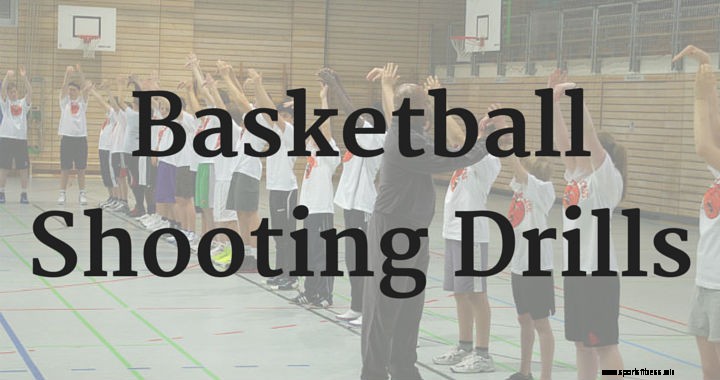
Si un entrenador usa los mismos ejercicios de tiro de baloncesto una y otra vez en la práctica, hay dos cosas principales que sucederán ...
- El equipo se aburrirá.
- El equipo dejará de dar el 100%.
Ningún entrenador quiere que suceda ninguna de estas cosas.
Tener una variedad de ejercicios de tiro para usar lo convertirá en un mejor entrenador de baloncesto y mantendrá a sus jugadores entusiasmados e interesados durante sus prácticas.
Todos los ejercicios de tiro de baloncesto a continuación contienen un PDF descargable e imprimible con instrucciones completas sobre cómo configurar y ejecutar el ejercicio. variaciones, sistemas de puntuación, y puntos de entrenamiento para recordar.
Aquí hay 20 ejercicios de tiro de baloncesto en equipo que puede usar para mantener frescas las prácticas y ayudar a su equipo a disparar en un porcentaje más alto.
20 ejercicios de tiro de baloncesto
Ejercicio n. ° 1 - Ejercicio de tiro de mano
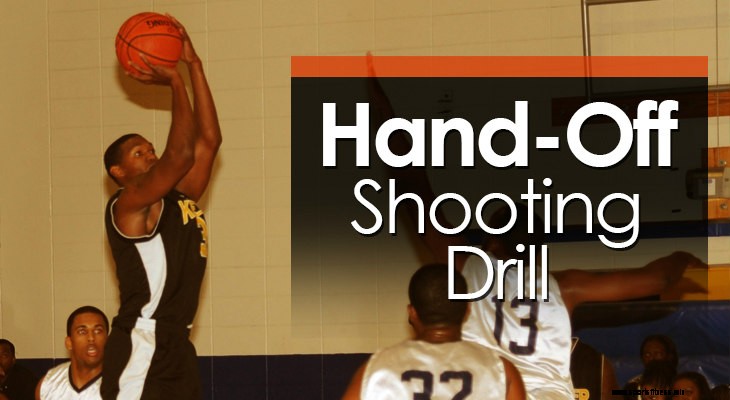
Cómo funciona el taladro:
Los jugadores en la parte superior de la tecla driblan hacia abajo y realizan un traspaso con un jugador lateral que corta hacia la parte superior de la tecla y luego realiza el tiro o conduce para la bandeja.
Objetivo:
Trabajar en disparar traspasos y realizarlos, ya que pueden ser difíciles de dominar para los jugadores a menos que se practiquen con frecuencia.
Configuración:
- Dos líneas en la parte superior de la clave. Ambos tienen dos pelotas de baloncesto en cada línea.
- Una línea de jugadores en el extremo inferior de cada ala.
Instrucciones:
Cómo funciona el taladro:Los jugadores en la parte superior de la llave driblan hacia abajo y realizan un traspaso con un jugador de ala cortando hacia el
parte superior de la tecla que luego realiza el tiro o conduce para la bandeja.
Objetivo:
Trabajar en disparar traspasos y realizarlos, ya que pueden ser difíciles de dominar para los jugadores.
a menos que se taladre con frecuencia.
Configuración:
• Dos líneas en la parte superior de la tecla. Ambos tienen dos pelotas de baloncesto en cada línea.
• Una línea de jugadores en el extremo inferior de cada ala.
Instrucciones:
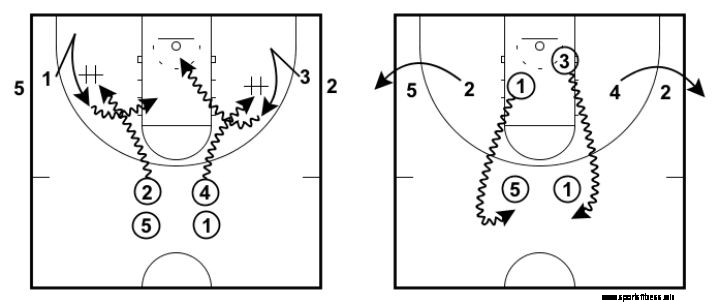
- Los primeros jugadores desde la parte superior de la llave driblan hacia el ala en sus respectivos lados. Al mismo tiempo, el jugador de ala debería hacer un corte hacia la línea de fondo.
- Asegurándose de cambiar las velocidades, el jugador de ala explota hacia el ala y recibe el hand-off y realiza un determinado tiro.
- La persona que deja la pelota de baloncesto se une al final de la línea de alas.
- El tirador rebota su pelota de baloncesto y luego se une a la línea en la parte superior de la llave en el lado opuesto al que disparó.
- El simulacro se ejecuta durante unos 5 minutos.
Variaciones:
Tirador - Da un paso atrás y dispara sin regatear, tirón de un regate desde el codo, dos botes atacan el aro para una bandeja, Conduzca la línea de fondo como si el defensor hiciera trampa debajo de la pantalla.
Competitivo - Si desea agregar un poco de competencia al ejercicio, establecer una cantidad objetivo de marcas para que el equipo las alcance dentro de un cierto límite de tiempo.
Distancia de transferencia - Puede ejecutar este ejercicio con los jugadores que realizan el traspaso en la línea de tres puntos, rango medio, o incluso más cerca para los jugadores más jóvenes.
Ejercicio n. ° 2 - Taladro de tiro con 23 conos
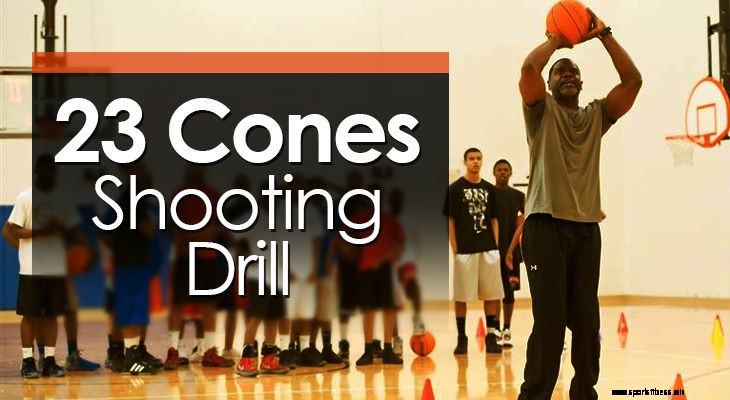
Cómo funciona el taladro:
Coloque 23 conos en la línea de fondo de un extremo del piso y divida a los jugadores en dos equipos en el otro extremo del piso. Los jugadores disparan y son "recompensados" permitiéndoles ir al otro extremo de la cancha y tener la oportunidad de recoger un cono si hacen otro tiro. Si fallan no obtienen nada y regresan al final de su línea. El equipo con más conos al final del juego. gana.
Objetivo:
Es una variación divertida de un ejercicio de tiro normal que mantiene a los jugadores interesados y emocionados. Los jugadores están disparando bajo mucha presión en el segundo tiro.
Configuración:
- Coloque 23 conos en el extremo opuesto de la cancha.
- Divida su grupo en dos equipos.
- Una pelota de baloncesto por equipo.
-
Instrucciones:
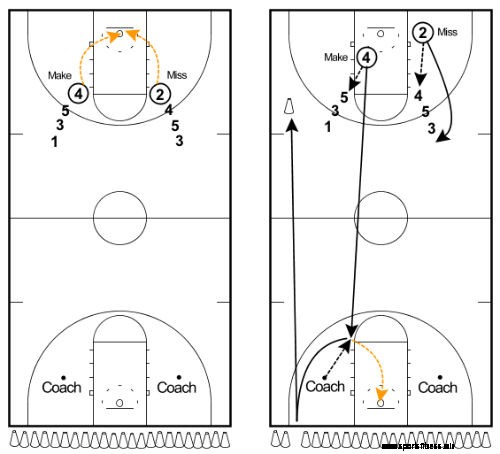
- Los jugadores comienzan a disparar con el silbato del entrenador.
- En cada marca de un equipo, la persona que tira debe rebotar la pelota y pasarla a la siguiente persona en la fila, luego son "recompensados" corriendo al otro extremo de la cancha y tienen la oportunidad de disparar un triple para ganar un cono para su equipo.
- El jugador solo tiene un intento. Si fallan no obtienen nada y regresan a su grupo. Si lo logran consiguen recoger un cono para su grupo.
- Luego, el jugador coloca el cono en la "casa segura" de su equipo cerca de su línea y se une al final de la línea.
Sistema de puntuación:
- ¡El equipo que termine con más conos al final del juego gana!
Variaciones:
Aumentar o disminuir los conos - También he usado este ejercicio con 13 o 33 conos. Utilice cualquier número de conos siempre que sea un número impar para que haya un ganador.
Posición de tiro - Por lo general, los adultos tiran tiros de tres puntos, pero los equipos juveniles pueden lanzar desde el codo o desde cualquier otro lugar de la cancha.
Sin segundo disparo - Si estoy entrenando a jugadores juveniles jóvenes, a menudo no les pido que hagan un segundo disparo en el otro extremo del piso. Simplemente tienen que correr hasta el otro extremo y conseguir uno.
Más grupos - En lugar de jugar con solo dos grupos, puedes crear hasta 4 grupos y colocar los conos en el medio de la cancha.
1. Los jugadores comienzan a disparar con el silbato del entrenador.2. En cada marca de un equipo, la persona que dispara debe
rebotar la pelota y pasarla a la siguiente persona en la fila, luego
son "recompensados" corriendo hacia el otro extremo del piso
y tener la oportunidad de disparar un triple para ganar un cono
para su equipo.
3. El jugador solo tiene un intento. Si fallan no obtienen nada
y volver a su grupo. Si lo logran llegan a recoger un
cono para su grupo.
4. Luego, el jugador coloca el cono en la "casa segura" de su equipo.
cerca de su línea y se une al final de la línea.
Sistema de puntuación:
• ¡El equipo que termine con más conos al final del juego gana!
23 Conos - Ejercicio de tiro www.basketballforcoaches.com
Variaciones:
Aumentar o disminuir los conos:también he usado este ejercicio con 13 o 33 conos. Usar cualquier
número de conos siempre que sea un número impar para que haya un ganador.
Posición de tiro:por lo general, los adultos tirarán triples, pero los equipos juveniles pueden disparar desde la
codo o en cualquier otro lugar del suelo.
Sin segunda oportunidad:si estoy entrenando a jugadores jóvenes, a menudo no les pido que hagan un segundo
disparado en el otro extremo del piso. Simplemente tienen que correr hasta el otro extremo y conseguir uno.
Más grupos:en lugar de jugar solo con dos grupos, puedes crear hasta 4 grupos y colocar
los conos en el medio de la cancha en su lugar.
Ejercicio n. ° 2 - Ejercicio de tiro con 23 conos
Ejercicio n. ° 3 - Tiros en salto de presión
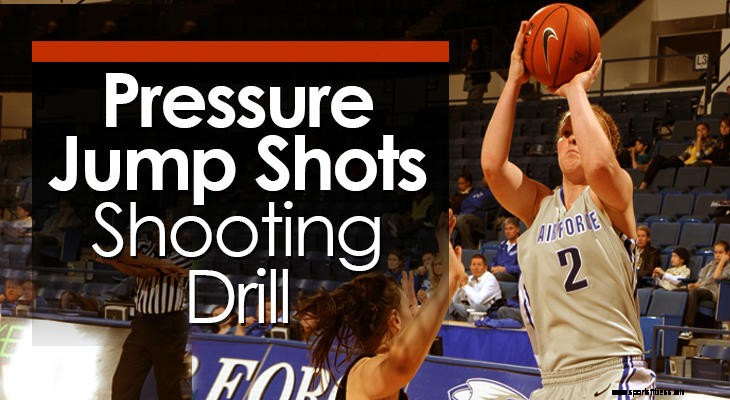
Cómo funciona el taladro:
Los jugadores deben completar ocho tiros (dos desde cada poste alto) bajo la presión de que si fallan el tiro deben unirse a la misma línea e intentarlo de nuevo.
Objetivo:
Permite a los jugadores practicar disparos en salto abiertos mientras están bajo presión mental.
Configuración:
- 4 filas de jugadores en cada codo. Pueden ser tantos jugadores como quieras.
- 4 pelotas de baloncesto. Uno con la primera persona en cada una de las líneas.
Instrucciones:
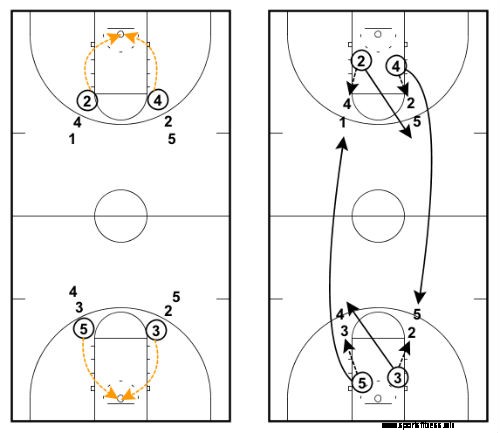 Cómo funciona el taladro:
Cómo funciona el taladro:Los jugadores deben completar ocho tiros (dos desde cada poste alto) mientras están bajo la presión de que si
pierden el tiro tienen que unirse a la misma línea y volver a intentarlo.
Objetivo:
Permite a los jugadores practicar disparos en salto abiertos mientras están bajo presión mental.
Configuración:
• 4 filas de jugadores en cada codo. Pueden ser tantos jugadores como quieras.
• 4 pelotas de baloncesto. Uno con la primera persona en cada una de las líneas.
Instrucciones:
- Cuando el entrenador dice que empiece, la primera persona de cada línea realiza un tiro y devuelve la pelota a la misma línea.
- Si hacen el tiro, se mueven a la siguiente línea, si fallan, se unen a la misma línea para intentarlo de nuevo.
- Este proceso continúa hasta que un jugador ha hecho un total de ocho tiros.
Sistema de puntuación:
- Cada jugador cuenta su propia cantidad de marcas hasta llegar a ocho tiros realizados (haga dos tiros de cada codo).
- Puede decidir si detenerse después de que haya un ganador o seguir jugando hasta que todos hayan terminado, dependiendo de la cantidad de tiempo que tenga.
Variaciones:
Ubicación y distancia de disparo - Cambia la distancia de disparo en función de la edad y coloca conos donde quieras que se tomen las cuatro tomas. He usado este ejercicio con jugadores juveniles muy jóvenes y tiros desde el bloque y con jugadores mayores que lanzan desde la línea de tres puntos.
Swishes solamente - Una variante difícil de este ejercicio que he usado antes es que solo cuentan los chasquidos. Esto debería dejarse en manos de los equipos más avanzados, ¡Pero hace que este ejercicio sea interesante!
Sistema de puntuación:• Cada jugador cuenta su propia cantidad de marcas hasta llegar a ocho tiros realizados (haga dos
disparos de cada codo).
• Puede decidir si detenerse después de que haya un ganador o seguir jugando hasta que todos hayan terminado
dependiendo de la cantidad de tiempo que tenga.
Variaciones:
Distancia y ubicación del disparo:cambie la distancia del disparo según la edad y coloque conos donde
desea que se tomen las cuatro tomas. He usado este ejercicio con jugadores juveniles muy jóvenes y disparé
desde el bloque y con jugadores mayores disparando desde la línea de tres puntos.
Swishes Only:una variación difícil de este ejercicio que he usado antes es que solo cuentan los swishes. Esta
debería dejarse en manos de los equipos más avanzados, ¡Pero hace que este ejercicio sea interesante!
Ejercicio n. ° 4 - Ejercicio de tiro rápido
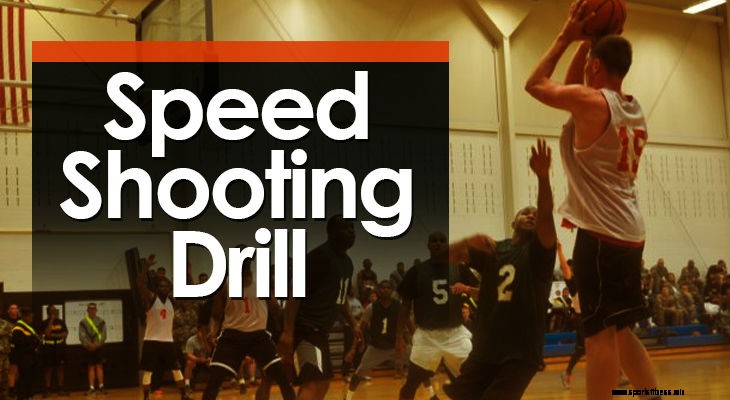
Cómo funciona el taladro:
Tres grupos se alinean a lo largo de la línea de base. El primer jugador del grupo corre por la pista con el balón, se detiene para un tiro, rebotes luego corre hacia el otro extremo y dispara, rebotes y pasa al siguiente jugador en la fila.
Objetivo:
Este ejercicio asegura que los jugadores estén fatigados al lanzar la pelota y trabaja en que los jugadores aprendan a desacelerar y mantener el equilibrio cuando lanzan la pelota.
Configuración:
- Divida el equipo en no más de 4 grupos (3 funciona mejor).
- Es mejor correr con 3 o 4 jugadores en cada grupo.
- Cada grupo tiene una pelota de baloncesto.
- Distribuya los grupos de manera uniforme a lo largo de la línea de base.
Instrucciones:
Cómo funciona el taladro:Tres grupos se alinean a lo largo de la línea de base. El primer jugador del grupo corre por la pista con el balón,
se detiene para un tiro, rebotes luego corre hacia el otro extremo y dispara, rebotes y
pasa al siguiente jugador en la fila.
Objetivo:
Este ejercicio asegura que los jugadores estén fatigados al disparar el
baloncesto y trabaja en que los jugadores aprendan a desacelerar y estar en
Equilibrio al lanzar la pelota.
Configuración:
• Divida el equipo en no más de 4 grupos (3 funciona mejor).
• Mejor carrera con 3 o 4 jugadores en cada grupo.
• Cada grupo tiene una pelota de baloncesto.
• Distribuya los grupos de manera uniforme a lo largo de la línea de base.
Instrucciones:
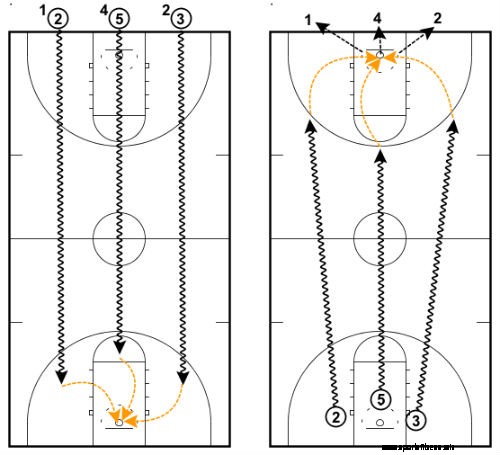
Los jugadores dispararán un tiro de tres puntos o un tiro de media distancia.
- En la llamada de los entrenadores, el primer jugador con la pelota corre hacia el otro extremo de la cancha con la pelota antes de tirar hacia arriba desde detrás de la línea de tres puntos o desde el medio rango.
- Al disparar, el jugador rebota con su propio tiro y corre hacia el otro extremo antes de levantarse y disparar nuevamente.
- Luego rebotan su propio tiro y se lo pasan a la siguiente persona en la fila. La siguiente persona no puede moverse desde el principio hasta que reciba la pelota de baloncesto.
- El siguiente jugador repite.
Sistema de puntuación:
Puntuación de grupo - Cada grupo mantiene su propia puntuación durante un tiempo determinado.
o
Puntaje total - El primer equipo en alcanzar cierta cantidad de marcas gana.
Variaciones:
Distancia de tiro - Si tiene un equipo de tiro más débil, puede hacer que se levanten desde el rango medio en lugar de la línea de tres puntos.
Numero de grupos - Los grupos no deben contener más de 4 jugadores y no debe haber más de 4 grupos a la vez.
Los jugadores dispararán un tiro de tres puntos o un tiro de media distancia.1. En la llamada de los entrenadores, el primer jugador con la pelota corre hacia el
otro extremo de la cancha con la pelota de baloncesto antes de tirar hacia arriba
desde detrás de la línea de tres puntos o desde el rango medio.
2. Al disparar, el jugador rebota con su propio tiro y corre
al otro extremo antes de tirar hacia arriba y disparar de nuevo.
3. Luego rebotan su propio tiro y lo pasan al siguiente
persona en la fila. La siguiente persona no puede moverse desde el principio.
hasta que reciban la pelota de baloncesto.
4. El siguiente jugador repite.
Sistema de puntuación:
Puntaje de grupo:cada grupo mantiene su propio puntaje para un cierto
cantidad de tiempo.
o
Puntuación total:el primer equipo en alcanzar una cierta cantidad de marcas gana.
www.basketballforcoaches.com
Velocidad - Ejercicio de tiro www.basketballforcoaches.com
Variaciones:
Distancia de tiro:si tiene un equipo de tiro más débil, puede hacer que se levanten desde el rango medio
en lugar de la línea de tres puntos.
Número de grupos:los grupos no deben contener más de 4 jugadores y no debe haber más
de 4 grupos a la vez.
Ejercicio n. ° 5 - Disparos fuera de la forma de regate
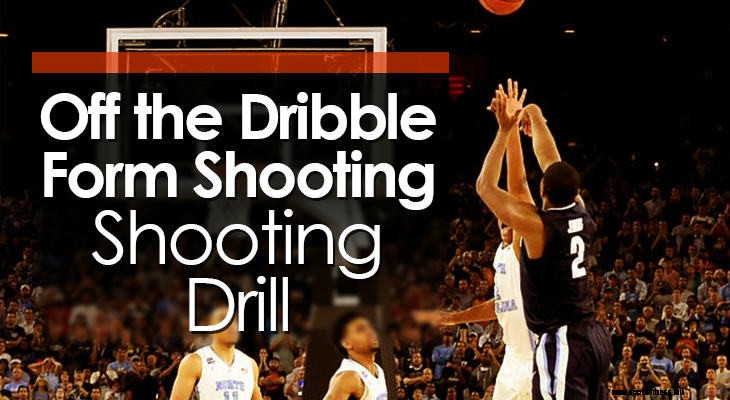
Cómo funciona el taladro:
Los jugadores practican el paso 1-2 o el salto dos veces con una simulación de bombeo y luego usan el paso 1-2 o el salto para disparar un tiro en suspensión en el tercer uso del juego de pies.
Objetivo:
Enseñar a los jugadores a lanzar el drible usando el paso 1-2 o el salto con el
juego de pies y mientras está equilibrado. Un gran ejercicio para los jugadores que suelen perder el equilibrio cuando disparan después de un regate.
Configuración:
- Todo jugador debe tener una pelota de baloncesto.
- Tres líneas a un par de metros de la línea de tres puntos.
- Número similar de jugadores en cada línea.
Instrucciones de formulario:
Formulario de tiro de 1-2 pasos
- Los jugadores comienzan cada repetición en la posición de triple amenaza.
- Los jugadores botan la pelota al mismo tiempo que dan un paso con el pie de tiro dominante (pie derecho para diestros y pie izquierdo para zurdos).
- Reúna la pelota de baloncesto plantando el pie de tiro no dominante (que ahora es su pie de pivote) y luego dispare mientras avanza con su pie de tiro dominante.
Ejemplo:jugador diestro
- Empiece con una postura de triple amenaza.
- Rebota la pelota al mismo tiempo que pisa con el pie derecho.
- Reúna la pelota plantando la izquierda y luego dando un paso hacia arriba con el pie derecho antes de disparar.
La forma de tiro de salto
- Los jugadores comienzan cada repetición en la posición de triple amenaza.
- Los jugadores hacen rebotar la pelota al mismo tiempo que dan un paso con cualquier pie (preferencia personal).
- Luego empujan el pie con el que dieron un pequeño salto y aterrizan con ambos pies al mismo tiempo antes de levantarse para disparar.
Ejemplo:jugador diestro
- Empiece con una postura de triple amenaza.
- Rebota la pelota al mismo tiempo que pisa con cualquier pie.
- Realiza un pequeño salto y recoge la pelota de baloncesto en el aire.
- Aterriza con ambos pies al mismo tiempo y levántate para disparar.
Instrucciones:
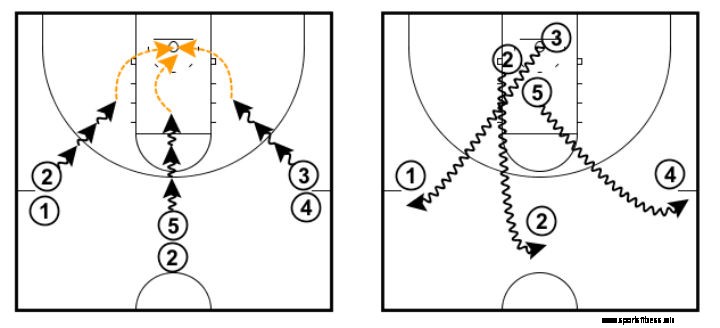 Cómo funciona el taladro:
Cómo funciona el taladro:Los jugadores practican el paso 1-2 o el salto dos veces con una simulación de bombeo y luego usan el paso 1-2 o
el salto para lanzar un tiro en suspensión en el tercer uso del juego de pies.
Objetivo:
Enseñar a los jugadores a lanzar el drible usando el paso 1-2 o el salto con el
juego de pies y mientras está equilibrado. Un gran ejercicio para los jugadores que suelen perder el equilibrio cuando disparan.
después de driblar.
Configuración:
• Todo jugador debe tener una pelota de baloncesto
• Tres líneas a un par de metros de la línea de tres puntos.
• Número similar de jugadores en cada línea.
Instrucciones de formulario:
Formulario de tiro de 1-2 pasos
1. Los jugadores comienzan cada repetición en la posición de triple amenaza.
2. Los jugadores hacen rebotar la pelota al mismo tiempo que dan un paso con el pie de tiro dominante (derecha
pie para diestros y pie izquierdo para zurdos).
3. Reúna la pelota de baloncesto plantando el pie de tiro no dominante (que ahora es su pie de pivote)
y luego dispara mientras avanzan con su pie de disparo dominante.
Ejemplo:jugador diestro
• Comience con una postura de triple amenaza.
• Hacer rebotar la pelota al mismo tiempo que pisa con el pie derecho.
• Recoja la pelota plantando la izquierda y luego dando un paso hacia arriba con el pie derecho antes de disparar.
La forma de tiro de salto
1. Los jugadores comienzan cada repetición en la posición de triple amenaza.
2. Los jugadores botan la pelota al mismo tiempo que dan un paso con cualquiera de sus pies (preferencia personal).
3. Luego empujan el pie con el que dieron un pequeño salto y aterrizan con ambos pies en el
mismo tiempo antes de levantarse para el tiro.
Ejemplo:jugador diestro
• Comience con una postura de triple amenaza.
www.basketballforcoaches.com
Tiro fuera de forma de regate - Ejercicio de tiro www.basketballforcoaches.com
• Rebotar la pelota al mismo tiempo que pisa con cualquier pie.
• Realiza un pequeño salto y recoge la pelota de baloncesto en el aire.
• Aterriza con ambos pies al mismo tiempo y levántate para el tiro.
Instrucciones:
- Lo primero que debe hacer es mostrar a los jugadores el juego de pies correcto para usar usando las instrucciones del formulario de arriba.
- El primer jugador de cada línea practica el formulario 3 veces. Las dos primeras veces terminan en una falsa bomba y la tercera termina en un tiro en suspensión.
- Después de recibir su propio rebote, únase a otra línea.
Variaciones:
Agregar más líneas - Si tiene una gran cantidad de personas, puede agregar más líneas para que los jugadores puedan tener más repeticiones. Sin embargo, trate de no tener demasiados porque dificulta que los entrenadores observen y hagan correcciones en la forma.
Utilice el salto o el paso 1-2 - Enseñe a los jugadores cómo disparar con ambos y luego creo que debe dejar que cada jugador individual decida cuál se siente más cómodo para ellos.
Distancia - Ajuste la distancia desde el ring para que en el tercer uso del juego de pies cuando los jugadores disparen, están disparando desde una distancia cómoda.
Sin rotación de línea - Si los jugadores se confunden o las líneas siguen teniendo una cantidad desigual de jugadores, considere decirles a los jugadores que regresen a la misma línea después de cada tiro en lugar de cambiar.
1. Lo primero que debe hacer es mostrar a los jugadores lajuego de pies para usar usando las instrucciones del formulario arriba.
2. El primer jugador de cada línea practica el formulario 3 veces. El primero
dos veces terminan en una bomba falsa y la tercera termina en un salto
Disparo.
3. Después de recibir su propio rebote, únase a otra línea.
Variaciones:
Agregar más líneas:si tiene una gran cantidad de personas, puede agregar más líneas para que los jugadores
puede tener más repeticiones. Sin embargo, trate de no tener demasiados porque dificulta la
entrenadores para observar y hacer correcciones para formar.
Usa el salto o el paso 1-2:enseña a los jugadores cómo disparar usando ambos y luego creo que
debe dejar que cada jugador decida cuál le resulta más cómodo.
Distancia:ajuste la distancia desde el anillo para que en el tercer uso del juego de pies cuando
los jugadores disparan, están disparando desde una distancia cómoda.
Sin rotación de línea:si los jugadores se confunden o las líneas siguen teniendo una cantidad desigual de
jugadores considere decirles a los jugadores que regresen a la misma línea después de cada tiro en lugar de cambiar.
Ejercicio n. ° 6 - Layups de tejido
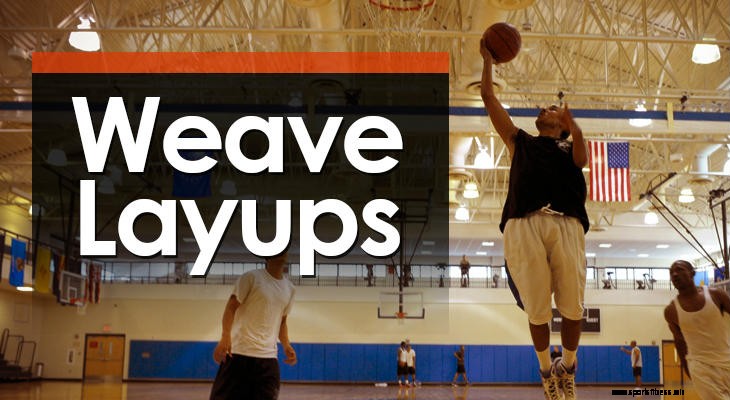
Cómo funciona el taladro:
Los jugadores tejen desde la mitad de la cancha y terminan en una bandeja de un jugador de banda. El jugador del medio rebota la pelota, pases de salida, y luego la pelota vuelve al inicio.
Objetivo:
Un ejercicio de ritmo rápido que funciona en pases y bandejas a toda velocidad y bajo presión de tiempo. Un gran ejercicio para aumentar la intensidad del entrenamiento.
Configuración:
- Tres líneas pares en media cancha con al menos dos jugadores en cada una. Pueden ser tantos como tengas.
- Una pelota de baloncesto en la línea media.
Instrucciones:
Cómo funciona el taladro:Los jugadores tejen desde la mitad de la cancha y terminan en una bandeja de un jugador de banda. El jugador del medio rebota el
bola, pases de salida, y luego la pelota vuelve al inicio.
Objetivo:
Un ejercicio de ritmo rápido que funciona en pases y bandejas a toda velocidad y bajo presión de tiempo. A
gran ejercicio para aumentar la intensidad en el entrenamiento.
Configuración:
• Tres líneas pares en media cancha con al menos dos jugadores en cada una. Puede ser
tantos más como tengas.
• Una pelota de baloncesto en la línea media.
Instrucciones:
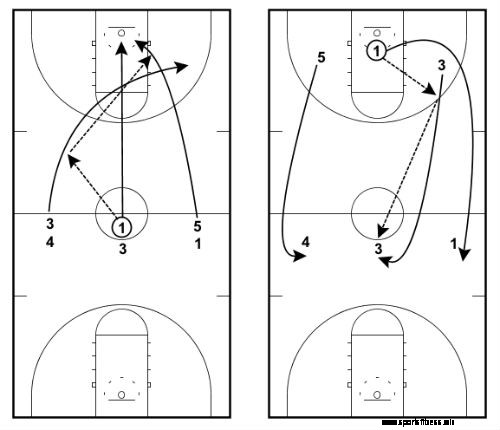
Instrucciones para realizar este ejercicio para una bandeja con la mano derecha. Revertir todo
para la mano izquierda.
- El jugador de la línea media pasa el balón al jugador que corre por la banda izquierda, quien inmediatamente se lo pasa al jugador que corre por la banda derecha para una bandeja.
- Inmediatamente después de que el jugador de la banda izquierda pasa la pelota, debe correr a través de la cancha y prepararse para recibir el pase de salida.
- El jugador del medio que inició el ejercicio corre por el medio y rebota el balón después de que la banda derecha ha hecho una bandeja y ha continuado.
- El jugador del medio luego se gira y pasa la pelota al jugador de salida, quien la atrapa e inmediatamente pasa a la siguiente persona en la línea en la línea media en la mitad de la cancha.
- Tan pronto como el jugador del medio atrapa la pelota, el siguiente grupo repite el mismo proceso.
Sistema de puntuación:
- El equipo compite contra el reloj para hacer tantas bandejas como sea posible en una determinada cantidad de tiempo.
- El simulacro se ejecuta durante 2-3 minutos.
Variaciones:
Mano izquierda - Invierta todo el ejercicio y haga que su equipo realice el ejercicio con una bandeja con la mano izquierda en lugar de con la mano derecha.
Dispara desde el bloque - En lugar de una bandeja, los jugadores realizan un tiro en suspensión desde el bloque. No recomendaría disparar desde mucho más lejos o los rebotes serán demasiado largos y arruinarán el ejercicio.
Instrucciones para realizar este ejercicio para una bandeja con la mano derecha. Revertir todopara la mano izquierda.
1. El jugador de la línea media pasa el balón al jugador que corre por la
ala izquierda que inmediatamente se la pasa al jugador que corre por la
ala derecha para una bandeja.
2. Inmediatamente después de que el jugador de la banda izquierda pase el balón, debe
Corre a toda velocidad por la cancha y prepárate para recibir el pase de salida.
3. El jugador del medio que inició el ejercicio corre por el medio y
Rebota el balón después de que la banda derecha haya realizado una bandeja y
continuó a través.
4. El jugador del medio se gira y pasa el balón al jugador de salida.
que atrapa e inmediatamente pasa a la siguiente persona en la fila en el
línea media en media cancha.
5. Tan pronto como el jugador del medio atrape la pelota, el siguiente grupo repita
el mismo proceso.
Sistema de puntuación:
• El equipo compite contra el reloj para hacer tantas bandejas como pueda en una cierta cantidad de
tiempo.
• El simulacro se ejecuta durante 2 a 3 minutos.
www.basketballforcoaches.com
Bandejas de tejido - Ejercicio de tiro www.basketballforcoaches.com
Variaciones:
Mano izquierda:invierta todo el ejercicio y haga que su equipo realice el ejercicio con una bandeja con la mano izquierda
en lugar de la mano derecha.
Dispara desde el bloque:en lugar de una bandeja, los jugadores realizan un tiro en suspensión desde el bloque. Yo no lo haría
Recomiendo disparar desde mucho más lejos o los rebotes serán demasiado largos y arruinará el ejercicio.
Ejercicio n. ° 7 - Bandejas de Cincinnati
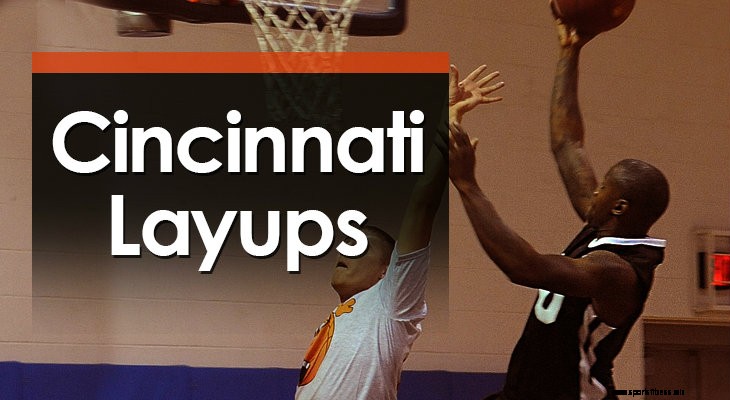
Cómo funciona el taladro:
Una línea de jugadores en la mitad de la cancha y en el ala, y un solo jugador en la línea de tiros libres. El jugador en la mitad de la cancha pasa al jugador en la línea de tiros libres que luego pasa al jugador de banda cortante para una bandeja.
Objetivo:
Este es un gran ejercicio de calentamiento para jugadores jóvenes que trabaja en la bandeja y en las habilidades de pase. También es excelente para la concentración, ya que enfatizamos que la pelota nunca debe golpear el piso.
Configuración:
- Una fila de jugadores en medio de la mitad de la cancha, una línea de jugadores en el ala, y un solo jugador en la línea de tiros libres.
- Necesitará una o dos pelotas de baloncesto, todas comenzando con el grupo de media cancha.
Instrucciones:
Cómo funciona el taladro:Una línea de jugadores en la mitad de la cancha y en el ala, y un solo jugador en la línea de tiros libres. El jugador
en la mitad de la cancha pasa al jugador en la línea de tiros libres que luego pasa al jugador de banda cortante
para una bandeja.
Objetivo:
Este es un gran ejercicio de calentamiento para jugadores jóvenes que trabaja en la bandeja y en las habilidades de pase. También genial
para la concentración, ya que enfatizamos que la pelota nunca debe golpear el suelo.
Configuración:
• Una fila de jugadores en el medio de la mitad de la cancha, una línea de jugadores
en el ala, y un solo jugador en la línea de tiros libres.
• Necesitará una o dos pelotas de baloncesto, todas comenzando con la mitad
grupo de la corte.
Instrucciones:
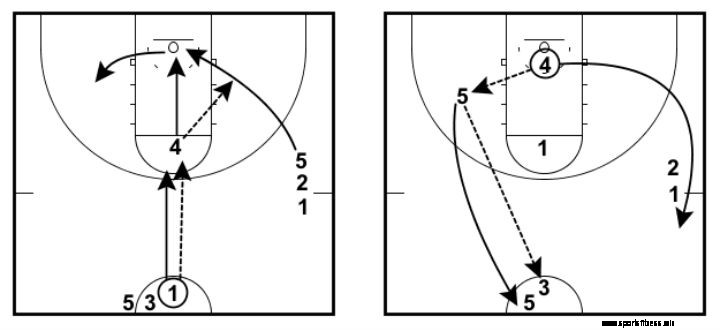
- La primera persona con una pelota de baloncesto en la línea de media cancha se la pasa al jugador en la línea de tiros libres e inmediatamente corre hacia la línea de tiros libres para reemplazarlos.
- El jugador que recibe el primer pase en la línea de tiros libres pasa al jugador de banda que debería estar cortando fuerte hacia el aro. El ala debe recibir el balón y hacer una bandeja sin botar el balón.
- Después de que el jugador lateral realiza una bandeja, siguen corriendo para ser utilizados como un paso de salida.
- La persona que pase de la línea de tiros libres al lateral rebota el balón, salidas al mismo jugador que hizo la bandeja, y luego corre hacia la línea de bandeja.
- El jugador que recibe el pase de salida lo pasa a la línea de media cancha y luego se une al final de la misma.
Variaciones:
Competitivo - Los jugadores deben hacer una cierta cantidad de bandejas seguidas. Esto pone mucha presión en cada bandeja.
Otro lado del suelo - Si inició el ejercicio en el lado derecho (los jugadores terminan con la mano derecha), luego cambie la línea de las alas al otro lado de la cancha para que los jugadores deban terminar con la mano izquierda.
Tiros en salto - En lugar de bandejas, los jugadores pueden hacer un tiro en suspensión. Los disparos desde el bloque están bien pero los problemas comienzan si disparas mucho más lejos porque el ejercicio depende de que el tirador sea el pase de salida al otro lado de la cancha.
1. La primera persona con una pelota de baloncesto en la línea de media cancha.se lo pasa al jugador en la línea de tiros libres y luego
corre inmediatamente hacia la línea de tiros libres para reemplazarlos.
2. El jugador que recibe el primer pase en la línea de tiros libres.
pasa al jugador de banda que debería estar cortando fuerte al
anillo. El ala debe recibir el balón y hacer una bandeja.
sin regatear el balón.
3. Después de que el jugador lateral realiza una bandeja, ellos siguen corriendo
a través para ser utilizado como un paso de salida
4. La persona que pasa de la línea de tiros libres al lateral.
jugador rebota la pelota, salidas al mismo jugador que hizo
la bandeja, y luego corre hacia la línea de bandeja.
5. El jugador que recibe el pase de salida lo pasa a la mitad
línea de corte y luego se une al final de la misma.
Variaciones:
Competitivo:los jugadores deben hacer una cierta cantidad de bandejas seguidas. Esto pone mucha presión
en cada bandeja.
El otro lado de la cancha:si comenzaste el ejercicio en el lado derecho (los jugadores terminaron con su
mano derecha), luego cambie la línea de las alas al otro lado de la cancha para que los jugadores deben terminar con
su mano izquierda.
www.basketballforcoaches.com
Cincinnati - Ejercicio de tiro www.basketballforcoaches.com
Tiros en suspensión:en lugar de bandejas, los jugadores pueden levantarse para realizar un tiro en suspensión. Los disparos desde el bloque están bien
pero los problemas comienzan si disparas mucho más lejos porque el ejercicio depende de que el tirador sea el
paso de salida en el otro lado del piso.
Ejercicio # 8 - Dar y seguir disparando
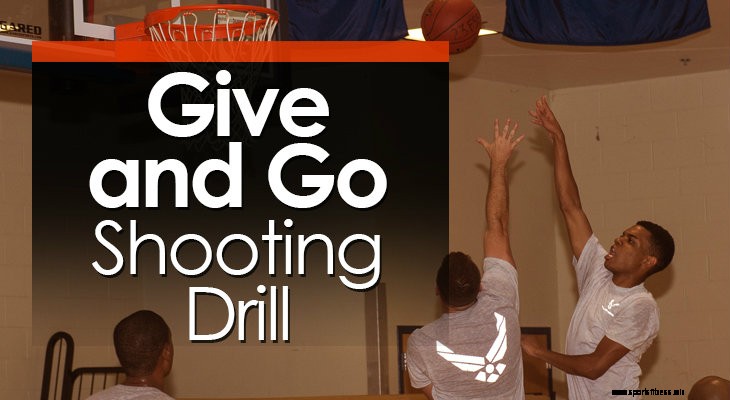
Cómo funciona el taladro:
Los jugadores entran y salen de los conos, pasar al entrenador, recibir la pelota de vuelta, y luego dispara una variedad de tiros desde la captura cambiando de lado cada vez que disparan.
Objetivo:
Para trabajar en las habilidades de regate, juego de pies desde la recepción y una variedad de tiros.
Configuración:
- Cada jugador tiene una pelota de baloncesto.
- Dos entrenadores.
- Dos líneas en la línea media a cada lado de la cancha.
- Opcional:3 conos cerca de la mitad para practicar el regate.
Instrucciones:
Cómo funciona el taladro:Los jugadores entran y salen de los conos, pasar al entrenador, recibir la pelota de vuelta, y luego dispara un
variedad de tiros de la captura cambiando de lado cada vez que disparan.
Objetivo:
Para trabajar en las habilidades de regate, juego de pies desde la recepción y una variedad de tiros.
Configuración:
• Cada jugador tiene una pelota de baloncesto.
• Dos entrenadores.
• Dos líneas en la línea de medio campo a cada lado de la cancha.
• Opcional:3 conos cerca de la mitad para practicar el regate.
Instrucciones:
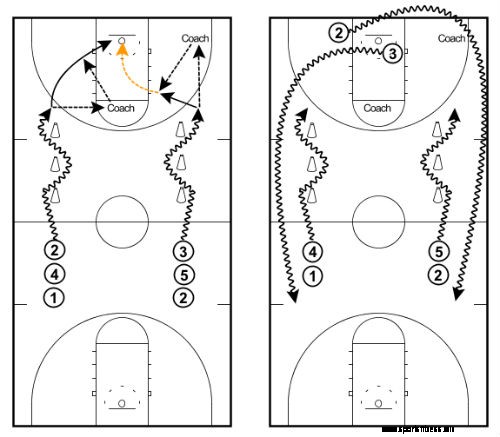
Opciones de disparo de taladro:
- Atrapar y disparar
- Captura, falsa bomba, disparo.
- Captura, falsa bomba, conducir.
- Atrapa y conduce.
- Captura, pull up con un regate.
- y cualquier otro que se te ocurra.
- El entrenador primero debe decirles a los jugadores en qué tipo de tiro van a trabajar primero.
- En la llamada de los entrenadores para comenzar, el primer jugador comienza a tejer dentro y fuera de los conos.
- Al final del regate, el jugador realiza un pase de pecho con las dos manos al entrenador o un pase de empuje con una mano, según la edad y el nivel de habilidad.
- El entrenador atrapa y pasa al primer jugador que luego realiza el tiro elegido.
- Tan pronto como el entrenador haya pasado al jugador, la siguiente persona en la fila comenzará a regatear.
- Después del tiro, el jugador rebota con su propio tiro y regatea por la línea lateral opuesta para unirse a la línea opuesta.
Variaciones:
Sin conos de goteo - Si simplemente desea concentrarse en la parte del juego de pies del ejercicio, puede sacar los conos.
Utilice la cancha completa - Si tiene 4 entrenadores (o padres), puede aumentar la cantidad de tiros que recibirá cada jugador ejecutando 4 estaciones en lugar de dos. Haga que los jugadores giren en el sentido de las agujas del reloj cada vez que disparen.
Competitivo - El primer jugador en hacer una cierta cantidad de tiros desde cada punto es el ganador.
Drill shooting options:- Catch and shoot
- Catch, pump fake, shoot.
- Catch, pump fake, drive.
- Catch and drive.
- Catch, one-dribble pull up.
- and any others you can think of.
1. The coach must first tell the players which shot type they’re going
to work on first.
2. On the coaches call to start, the first player starts weaving in and
out of the cones.
3. At the end of the dribbling the player either makes a two-handed
chest pass to the coach or a 1-handed push pass depending on
age and skill level.
4. The coach catches and passes back to the first player who then
performs the chosen shot.
5. As soon as the coach has passed to the player the next person
in line starts dribbling.
6. After the shot the player rebounds their own shot and dribbles up
the opposite sideline to join the opposite line.
www.basketballforcoaches.com
Give and Go - Shooting Drill www.basketballforcoaches.com
Variaciones:
No Dribbling Cones - If you simply want to focus on the footwork part of the drill then you can
take out the cones.
Use the Full Court - If you have 4 coaches (or parents) you can increase the number of shots
each player will get by running 4 stations instead of two. Have the players rotate clockwise each
time they shoot.
Competitive - The first players to make a certain amount of shots from each spot is the winner.
Drill #9 - Screen Shooting
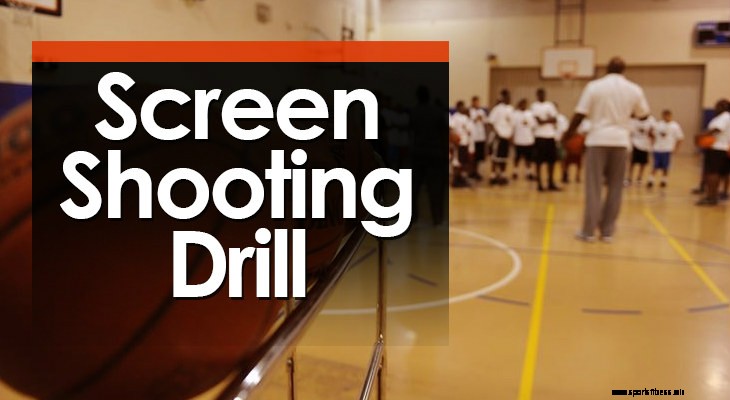
Cómo funciona el taladro:
Players will start at the top of the key and start the drill by cutting down the lane until they’re under the basket. From here they will cut off one of the screens and receive a pass from the next player in line before taking a shot. They then rebound their shot and return to the line at the top of the key.
Objetivo:
This drill will teach your players how to use different cuts off an off-ball screen and to practice scoring off those cuts.
Configuración:
- Two chairs or cones to act as the screen on both sides of the floor.
- All players lined up at the top of the key.
- Everyone has a basketball except the person at the front of the line.
Instrucciones:
Cómo funciona el taladro:Players will start at the top of the key and start the drill by cutting down the lane until they’re under
the basket. From here they will cut off one of the screens and receive a pass from the next player
in line before taking a shot. They then rebound their shot and return to the line at the top of the key.
Objetivo:
This drill will teach your players how to use different cuts off an off-ball screen and to practice
scoring off those cuts.
Configuración:
• Two chairs or cones to act as the screen on both sides
of the floor.
• All players lined up at the top of the key.
• Everyone has a basketball except the person at the
front of the line.
Instrucciones:
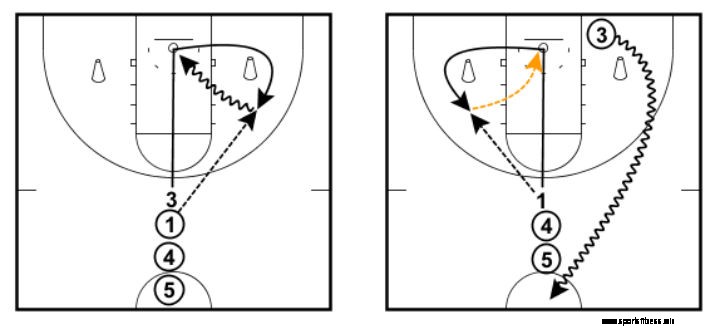
The 4 main cuts off the screen are:
- Flare cut
- Straight cut
- Curl cut
- Backdoor cut
- Instruct the players which cut they should be using off the screen. You can run 1-2 minutes of each cut or let them choose themselves.
- To start the drill the first player cuts directly underneath the basket before changing pace and exploding out to use one of the screens. The next person in line passes to the shooter coming off the screen.
- After the shot the player that passed the ball then becomes the cutter and uses the screen on the other side of the floor before receiving a pass from the next player in line.
- This process continues for about 5 minutes making sure to regularly change the type of shot the players are taking.
Variaciones:
Two Lines - If you have a lot of players, instead of running one line in the middle of the floor you can create two lines at the top of the key. This means each group sticks to their own side of the floor and runs off the same screen every time.
Different Cuts - Make sure you’re varying the shots between the four different cuts listed at the start of the instructions section.
Competitive - If you want to make it competitive you can make it a game by setting a target number of makes and the first player to reach that number wins.
The 4 main cuts off the screen are:- Flare cut
- Straight cut
- Curl cut
- Backdoor cut
1. Instruct the players which cut they should be using
off the screen. You can run 1-2 minutes of each cut
or let them choose themselves.
2. To start the drill the first player cuts directly
underneath the basket before changing pace and
exploding out to use one of the screens. El siguiente
person in line passes to the shooter coming off the
screen.
3. After the shot the player that passed the ball then
becomes the cutter and uses the screen on the other
side of the floor before receiving a pass from the next
player in line.
4. This process continues for about 5 minutes making sure to regularly change the type of shot
the players are taking.
www.basketballforcoaches.com
Off-Ball Screen Shooting - Shooting Drill www.basketballforcoaches.com
Variaciones:
Two Lines - If you have a lot of players, instead of running
one line in the middle of the floor you can create two lines
at the top of the key. This means each group sticks to their
own side of the floor and runs off the same screen every
tiempo.
Different Cuts - Make sure you’re varying the shots
between the four different cuts listed at the start of the
instructions section.
Competitive - If you want to make it competitive you can
make it a game by setting a target number of makes and
the first player to reach that number wins.
Drill #10 - Partner Form Shooting

Cómo funciona el taladro:
Players each have a partner and line up about 10 feet apart facing each other. They then shoot the ball to each other using correct technique so that their partner can catch it without moving.
Objetivo:
This drill should be used almost every training at a young age until each player has mastered basic shooting technique. It’s a great drill to get in many quick repetitions and gives the coaches a chance to correct the shooting form of all players.
Configuración:
- Players all find a partner.
- Players line up about 7 - 10 feet from each other or on two parallel lines picked by the coach.
- One basketball between two players.
Instrucciones:
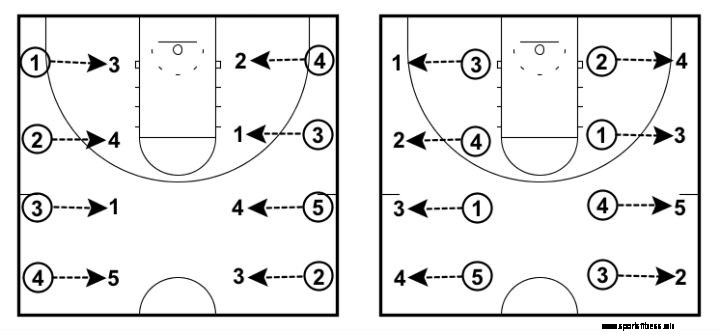 How the Drill Works
How the Drill Works Players each have a partner and line up about 10 feet apart facing each other. They then shoot the
ball to each other using correct technique so that their partner can catch it without moving.
Objetivo:
This drill should be used almost every training at a young age until each player has mastered basic
shooting technique. It’s a great drill to get in many quick repetitions and gives the coaches a
chance to correct the shooting form of all players.
Configuración:
• Players all find a partner.
• Players line up about 7 - 10 feet from each other or on two parallel lines picked by the coach.
• One basketball between two players.
Instrucciones:
- The coach must first demonstrate how they want the players to shoot the ball. Make sure to emphasize the key shooting points.
- Players then shoot the ball to each other for the given amount of time.
- Coaches walk around all groups and evaluate and make corrections to each shooter individually.
Variaciones:
Odd Number of Players - When you have an odd number of players you can find a parent or spare coach to fill in and be their partner, or one of the players can perform the ‘line shooting’ drill, which is the same except they have to retrieve their ball after every shot.
Shoot with One Hand - Can run this drill using one hand only to shoot the ball. This ensures that players aren’t pushing the ball with their off-hand as well.
1. The coach must first demonstrate how they want theplayers to shoot the ball. Make sure to emphasize the
key shooting points.
2. Players then shoot the ball to each other for the given
amount of time.
3. Coaches walk around all groups and evaluate and make
corrections to each shooter individually.
Variaciones:
Odd Number of Players - When you have an odd number of players you can find a parent or
spare coach to fill in and be their partner, or one of the players can perform the ‘line shooting’ drill
found on page ____ which is the same except they have to retrieve their ball after every shot.
Shoot with One Hand - Can run this drill using one hand only to shoot the ball. This ensures that
players aren’t pushing the ball with their off-hand as well.
Drill #11 - 30 and 1 Shooting Drill
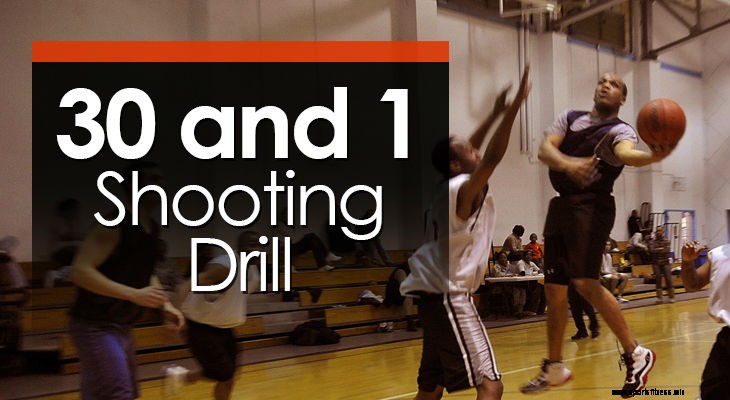
Cómo funciona el taladro:
Players will split up into groups and compete against each other. The coach picks three different spots on the floor that each group must make 10 shots from and then to finish the game the group must make one long-range shot as the game-winner. Equalling 31 made shots.
Objetivo:
A fun, competitive shooting drill that works on shots from different spots on the court including a long-range game-winner.
Configuración:
- Split players up into groups of preferably between 3 and 5 players. Though any number will work.
- Each group has one basketball.
- Tell the players the three spots they will shoot from before the half court shot. The traditional spots are 10 made shots from the block, the elbow, and the three-point line before the one made half-court shot.
Instrucciones:
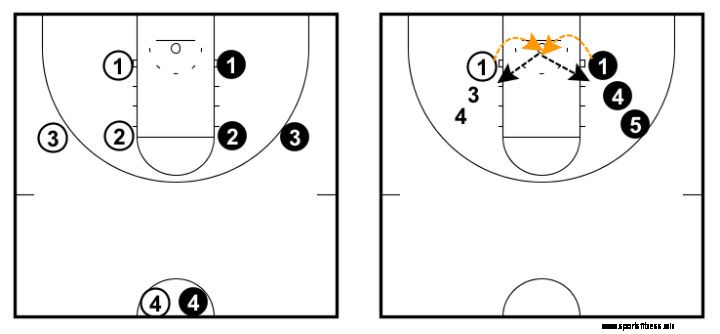
- On the coaches call, players start shooting from the first spot.
- The players rotate through taking their shot, rebounding, and passing the ball back to their line.
- Once the team has made 10 shots they move on to the next spot. The other team must keep shooting until they make 10 from each spot. All groups do not change when one team makes 10.
- The first team to make 10 from three spots and then make the long distance shot wins!
Scoring System:
- All shots are worth 1 point.
- The first team to 31 points is the winner.
Variaciones:
Shooting Spots - You can pick any three spots on the floor for players to shoot from, including:
• Layups
• Baseline
• Wing area
• Anywhere around 3-point arc.
• etc.
Long Distance Shot - The long distance shot is a great part of this drill because the players love it and it gives all groups a chance to catch up and win. If you have younger players you can make the three spots closer to the basket and then finish with a three-point game-winning shot or a halfcourt shot for older age groups.
1. On the coaches call, players start shooting from thefirst spot.
2. The players rotate through taking their shot,
rebounding, and passing the ball back to their line.
3. Once the team has made 10 shots they move on to the
next spot. The other team must keep shooting until
they make 10 from each spot. All groups do not
change when one team makes 10.
4. The first team to make 10 from three spots and then
make the long distance shot wins!
Scoring System:
• All shots are worth 1 point.
• The first team to 31 points is the winner.
Variaciones:
Shooting Spots - You can pick any three spots on the floor for players to shoot from, including:
• Layups
• Baseline
• Wing area
• Anywhere around 3-point arc.
• etc.
www.basketballforcoaches.com
30 and 1 - Shooting Drill www.basketballforcoaches.com
Long Distance Shot - The long distance shot is a great part of this drill because the players love it
and it gives all groups a chance to catch up and win. If you have younger players you can make
the three spots closer to the basket and then finish with a three-point game-winning shot or a halfcourt
shot for older age groups.How the Drill Works:
Players will split up into groups and compete against each other. The coach picks three different
spots on the floor that each group must make 10 shots from and then to finish the game the group
must make one long-range shot as the game-winner. Equalling 31 made shots.
Objetivo:
A fun, competitive shooting drill that works on shots from different spots on the court including a
long-range game-winner.
Configuración:
• Split players up into groups of preferably between 3 and 5 players. Though any number will work.
• Each group has one basketball.
• Tell the players the three spots they will shoot from before the half court shot. The traditional
spots are 10 made shots from the block, the elbow, and the three-point line before the one made
half-court shot.
Instrucciones:
Drill #12 - Chase Down Layups
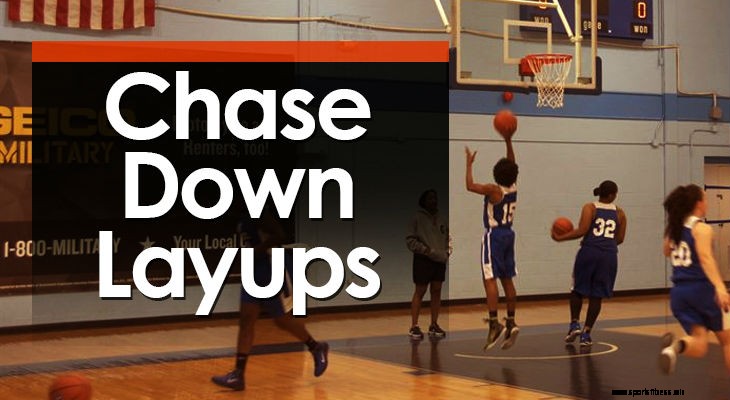
Cómo funciona el taladro:
Two lines of players on the baseline at each end of the court. The offensive player starts with an advantage and sprints the court and must lay the ball up while under pressure from the defensive player.
Objetivo:
To allow players to practice layups at full speed while under pressure from a defender. This drill also works on chase-down defense.
Configuración:
- Two lines of players on the baseline at each end of the court.
- Players in the offensive line all have a basketball.
- A coach at each end of the court to start the drill.
Instrucciones:
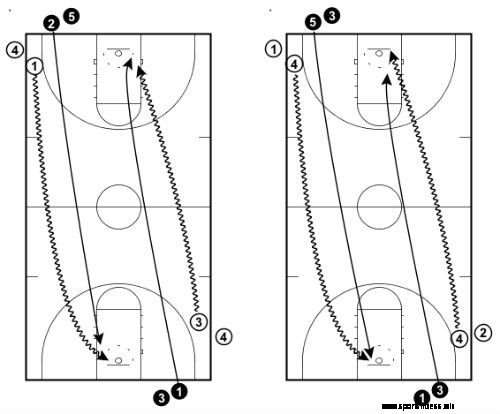 Cómo funciona el taladro:
Cómo funciona el taladro:Two lines of players on the baseline at each end of the court. The offensive player starts with an
advantage and sprints the court and must lay the ball up while under pressure from the defensive
jugador.
Objetivo:
To allow players to practice layups at full speed while under pressure from a defender. This drill
also works on chase-down defense.
Configuración:
• Two lines of players on the baseline at each end of the court.
• Players in the offensive line all have a basketball.
• A coach at each end of the court to start the drill.
Instrucciones:
- Coach starts by bringing the offensive player out a few steps depending on how fast they are compared to the defense to give them the fast break advantage.
- On the coach’s call, the offensive and defensive players sprint the floor.
- The offensive player’s goal is to make the layup and the defensive player’s goal is to challenge the layup without fouling.
- After the make or miss, both players join the end of the lines at their current end of the floor.
Variaciones:
Opposite Side of the Floor - Perform the drill from the other side of the floor so that the players have to dribble and make a layup with their left hand.
Competitive - Play until a player makes a certain amount of layups.
1. Coach starts by bringing the offensive player out a few stepsdepending on how fast they are compared to the defense to
give them the fast break advantage.
2. On the coach’s call, the offensive and defensive players sprint
the floor.
3. The offensive player’s goal is to make the layup and the
defensive player’s goal is to challenge the layup without
fouling.
4. After the make or miss, both players join the end of the lines at
their current end of the floor.
Variaciones:
Opposite Side of the Floor - Perform the drill from the other side of the floor so that the players
have to dribble and make a layup with their left hand.
Competitive - Play until a player makes a certain amount of layups.
Drill #13 - Fatigue Shooting Drill
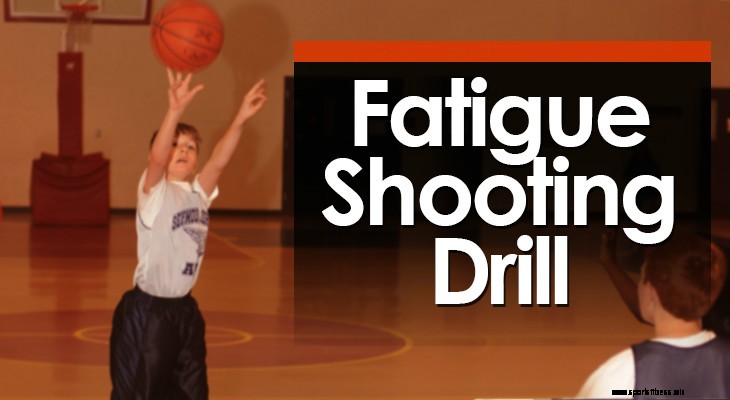
Cómo funciona el taladro:
Players are in groups of 3 or 4. The drill involves each player passing the ball to a shooter, sprinting the floor, receiving a pass for the shot, and then rebounding their own shot to pass to the next person.
Objetivo:
A fast-p aced drill that allows athletes to practice shooting while fatigued. Great drill to improve conditioning in all players.
Configuración:
- Players must be in groups of 3 or 4.
- In groups of 3 - A player on each baseline and a player in the middle of the court.
- If groups of 4 - An extra player behind one of the players on the baseline.
- Both players on the baseline have a basketball.
- Maximum of 3 groups on one court.
Instrucciones:
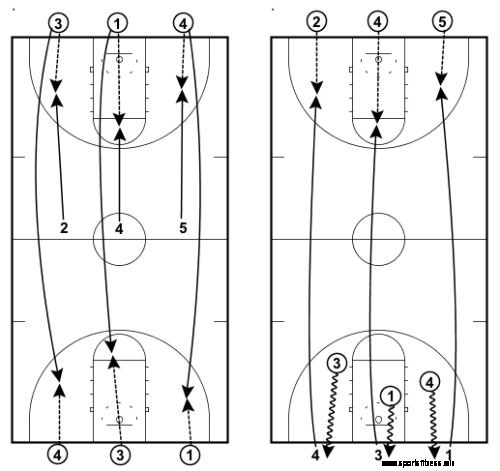
Instructions based on the drill being run with three groups of three players on a court.
- The three players in the middle of the court all sprint the same direction towards their partner. They receive the ball in shooting stance from the distance designated by the coach and take a shot.
- After the shot, the shooter rebounds their own ball and dribbles the ball out of bounds and waits to pass to the next player in their group.
- The player who passes the ball to the shooter immediately sprints down the other end of the court after passing and now becomes the next shooter.
- They will receive the pass off the player in their group at the other end of the court who will then sprint towards the original end to receive the pass from the first shooter.
- This cycle continues for 1 - 3 minutes before switching to a different type of shot.
Scoring System:
- Score as groups - The groups keep their own score and are playing against each other.
- Score as a team - All groups on the court count their score together and try to beat a targeted number. This requires the use of at least one coach down each end of the court to keep track of the amount of makes.
Variaciones:
Everyone has a basketball - This means that players will be full court speed dribbling into a shot instead of receiving a pass. The change over occurs when the player has taken a shot and got their rebound. Then the next player sprints down the other end.
Type of shot - You can run this drill using any of the following shots:
• Layups/Floaters
• Mid-range
• 3-pointers
• 1 dribble pull-up.
• 2 dribble pull-up.
1. The three players in the middle of the court all sprint the same direction towards their partner. They receive the ball in shooting stance from the distance designated by the coach and take a shot.
2. After the shot, the shooter rebounds their own ball and dribbles the ball out of bounds and waits to pass to the next player in their group.
3. The player who passes the ball to the shooter immediately sprints down the other end of the court after passing and now becomes the next shooter.
4. They will receive the pass off the player in their group at the other end of the court who will then sprint towards the original end to receive the pass from the first shooter.
5. This cycle continues for 1 - 3 minutes before switching to a different type of shot.
Scoring System:
1. Score as groups - The groups keep their own score and are playing against each other.
2. Score as a team - All groups on the court count their score together and try to beat a targeted number. This requires the use of at least one coach down each end of the court to keep track of the amount of makes.
Variaciones:
Everyone has a basketball - This means that players will be full court speed dribbling into a shot instead of receiving a pass. The change over occurs when the player has taken a shot and got their rebound. Then the next player sprints down the other end.
Type of shot - You can run this drill using any of the following shots:
• Layups/Floaters
• Mid-range
• 3-pointers
• 1 dribble pull-up.
• 2 dribble pull-up.How the Drill Works:
Players are in groups of 3 or 4. The drill involves each player passing the ball to a shooter, sprinting the floor, receiving a pass for the shot, and then rebounding their own shot to pass to the next person.
Objetivo:
A fast-paced drill that allows athletes to practice shooting while fatigued. Great drill to improve conditioning in all players.
Configuración:
• Players must be in groups of 3 or 4.
• In groups of 3 - A player on each baseline and a player in the middle of the court.
• If groups of 4 - An extra player behind one of the players on the baseline.
• Both players on the baseline have a basketball.
• Maximum of 3 groups on one court.
Instrucciones:
Drill #14 - Tennessee Shooting Drill
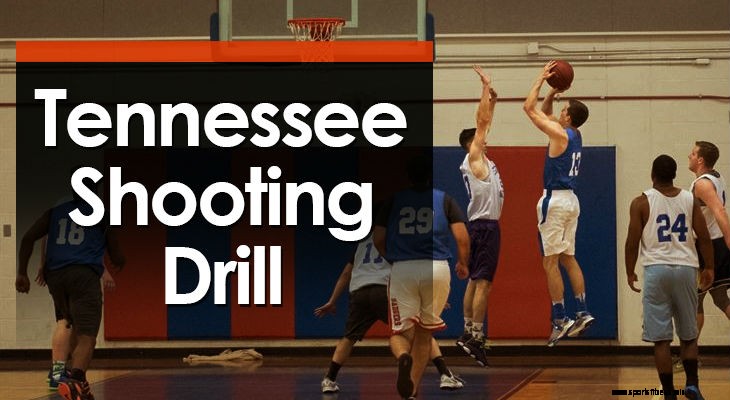
Cómo funciona el taladro:
The ball starts under the basket. On every trip down the floor there will be two passes and a layup. The first two passers must switch sides of the floor and then take a jump shot from either the high post or three-point line receiving the ball from the players on the sideline. The player that performs the layup then initiates the next trip down the floor with the two players that passed the ball to the shooters.
Objetivo:
A great drill for players to practice passing the ball ahead of them to a teammate running at full speed. It involves lots of shots at game speed and is great for basketball conditioning since the players must use quick bursts to sprint up and down the floor.
Configuración:
- You need about 10 players or more for this drill.
- Five basketballs.
- Set up by placing one player below the ring at one end of the court, and two people out of court on both sides of each freethrow line extended. Refer to the diagram.
- The first person underneath the ring will need a basketball.
- The second players in the two lines closest to the player under the ring will need a ball. (This is because the person starting under the ring passes to the players at the front of these lines).
- And the first player at the start of each line at the other end of the court will need a ball.
Instrucciones:
Cómo funciona el taladro:The ball starts under the basket. On every trip down the floor there will be two passes and a layup. The first two passers must switch sides of the floor and then take a jump shot from either the high post or three-point line receiving the ball from the players on the sideline. The player that performs the layup then initiates the next trip down the floor with the two players that passed the ball to the shooters.
Objetivo:
A great drill for players to practice passing the ball ahead of them to a teammate running at full speed. It involves lots of shots at game speed and is great for basketball conditioning since the players must use quick bursts to sprint up and down the floor.
Configuración:
• You need about 10 players or more for this drill.
• Five basketballs.
• Set up by placing one player below the ring at one end of the court, and two people out of court on both sides of each freethrow line extended. Refer to the diagram.
• The first person underneath the ring will need a basketball.
• The second players in the two lines closest to the player under the ring will need a ball. (This is because the person starting under the ring passes to the players at the front of these lines).
• And the first player at the start of each line at the other end of the court will need a ball.
Instrucciones:
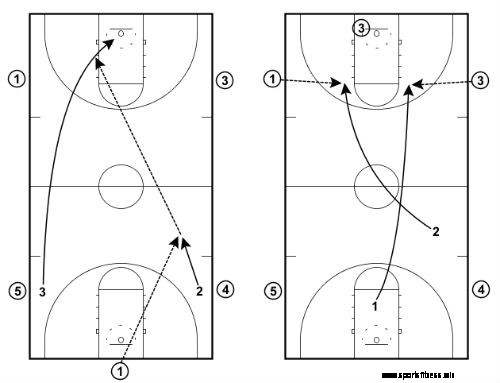
- The drill starts by (3) making an outlet pass to the first person in either line. For diagram purposes (3) passes to (4).
- (1) seeing this understands he will be performing the layup sprints the floor and receives the pass from (4) for the layup.
- After passing, players go to the side they passed the basketball to receive the pass for the jump shot. In this case, (3) receives the pass from (2) and (4) receives the pass from (5).
- (3) and (4) both take a jump shot from the designated area, collect their rebounds, and pass to the person at the front of their line.
- After completing the layup, (1) rebounds their own shot and now can outlet to either of the players that passed the basketball to the shooters.
- (1) outlet passes to (2) who then passes to (5) sprinting down the floor for the layup.
- (1) and (2) both sprint to the side they passed to and receive the pass for a jump shot.
- (5) now rebounds their own shot and starts the sequence again as (1) and (2) collect their rebounds and pass to the players at the front of each line.
- The drill continues like this for between 2 - 4 minutes.
Scoring System:
- 1 point per made shot. Either by the person performing a layup or the two shooters making a shot from the elbow. A maximum of three points can be obtained at each end of the floor.
- Run this drill without a set goal for your first time and take note of how many points the team scores in total. Then you can get a good idea of where they’re up to and set a goal for next time accordingly.
Variaciones:
Passing Line Change - Instead of the passing lines beginning on the extended free-throw line on each side of the court, each can start on the closest baseline between the middle and the side of the court.
1. The drill starts by (3) making an outlet pass to the first person in either line. For diagram purposes (3) passes to (4).2. (1) seeing this understands he will be performing the layup sprints the floor and receives the pass from (4) for the layup.
3. After passing, players go to the side they passed the basketball to receive the pass for the jump shot. In this case, (3) receives the pass from (2) and (4) receives the pass from (5).
4. (3) and (4) both take a jump shot from the designated area, collect their rebounds, and pass to the person at the front of their line.
5. After completing the layup, (1) rebounds their own shot and now can outlet to either of the players that passed the basketball to the shooters.
6. (1) outlet passes to (2) who then passes to (5) sprinting down the floor for the layup.
7. (1) and (2) both sprint to the side they passed to and receive the pass for a jump shot.
8. (5) now rebounds their own shot and starts the sequence again as (1) and (2) collect their rebounds and pass to the players at the front of each line.
9. The drill continues like this for between 2 - 4 minutes.
Scoring System:
• 1 point per made shot. Either by the person performing a layup or the two shooters making a shot from the elbow. A maximum of three points can be obtained at each end of the floor.
• Run this drill without a set goal for your first time and take note of how many points the team scores in total. Then you can get a good idea of where they’re up to and set a goal for next time accordingly.
Variaciones:
Passing Line Change - Instead of the passing lines beginning on the extended free-throw line on each side of the court, each can start on the closest baseline between the middle and the side of the court.
Drill #15 - Partner Shooting
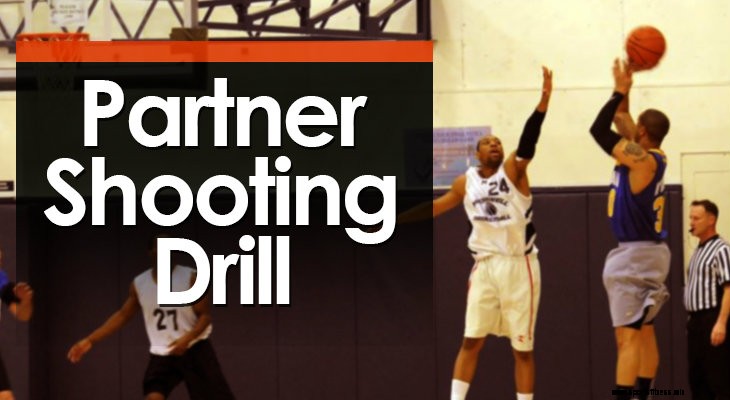
Cómo funciona el taladro:
Players take sets of 10 shots each. One person rebounds while the other shoots, back-pedals to half way and spots up again for the shot. Then they swap over.
Objetivo:
The drill works on shooting while fatigued, allows your players to get up a lot of shots, and lets them work on their complete scoring game by shooting from all areas of the floor.
Configuración:
- All players get a partner. If there’s an odd number the coach, assistant coach, or parent can rebound for one of the players.
- The player shooting stands at half court.
- The passer stands under the ring with a basketball.
- Coach tells the players which kind of shot to take. Either mid-range, three-point shot, one-dribble pull-up, or two-dribble pull-up, or floater.
Instrucciones:
Cómo funciona el taladro:Players take sets of 10 shots each. One person rebounds while the other shoots, back-pedals to half way and spots up again for the shot. Then they swap over.
Objetivo:
The drill works on shooting while fatigued, allows your players to get up a lot of shots, and lets them work on their complete scoring game by shooting from all areas of the floor.
Configuración:
• All players get a partner. If there’s an odd number the coach, assistant coach, or parent can rebound for one of the players.
• The player shooting stands at half court.
• The passer stands under the ring with a basketball.
• Coach tells the players which kind of shot to take. Either mid-range, three-point shot, one-dribble pull-up, or two-dribble pull-up, or floater.
Instrucciones:
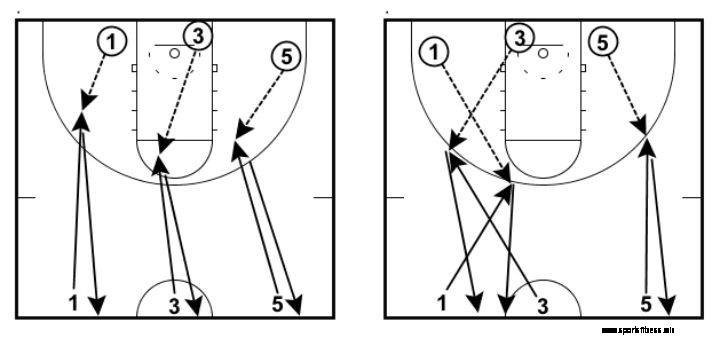
Change up where the shot is taken from between these five shots:
1. Mid-range shots.
2. Three-point shots.
3. 1-dribble pull-up shots.
4. 2-dribble pull-up shots.
5. Floater/layup.
- On the coaches call, the shooters at half way run in and receive the pass from their partner under the ring.
- Shooters take the shot and then back-pedal to half court while the passer rebounds the shot.
- The shooters continue this for the designated amount of shots the coach tells them to take.
- Once the shooter has shot the correct amount, the shooter and passer switch roles.
Scoring System:
- Shooter counts the amount of makes and rebounder counts the amount of shots taken.
- The player that makes the most amount of shots is the winner.
Variaciones:
Sideline - Players can backpedal to the sideline instead of the halfway line. This is perfect if you have three groups on each basket and they can rotate.
Different Shots - Make sure you’re changing the type of shot that players are taking after each round.
Made Shots - On a made shot players don’t have to backpedal to the sideline or half-way line.
Change up where the shot is taken from between these five shots:1. Mid-range shots.
2. Three-point shots.
3. 1-dribble pull-up shots.
4. 2-dribble pull-up shots.
5. Floater/layup.
1. On the coaches call, the shooters at half way run in and receive the pass from their partner under the ring.
2. Shooters take the shot and then back-pedal to half court while the passer rebounds the shot.
3. The shooters continue this for the designated amount of shots the coach tells them to take.
4. Once the shooter has shot the correct amount, the shooter and passer switch roles.
Scoring System:
• Shooter counts the amount of makes and rebounder counts the amount of shots taken.
• The player that makes the most amount of shots is the winner.
Variaciones:
Sideline - Players can backpedal to the sideline instead of the halfway line. This is perfect if you have three groups on each basket and they can rotate.
Different Shots - Make sure you’re changing the type of shot that players are taking after each round.
Made Shots - On a made shot players don’t have to backpedal to the sideline or half-way line.
Drill #16 - 5 Spot Variety
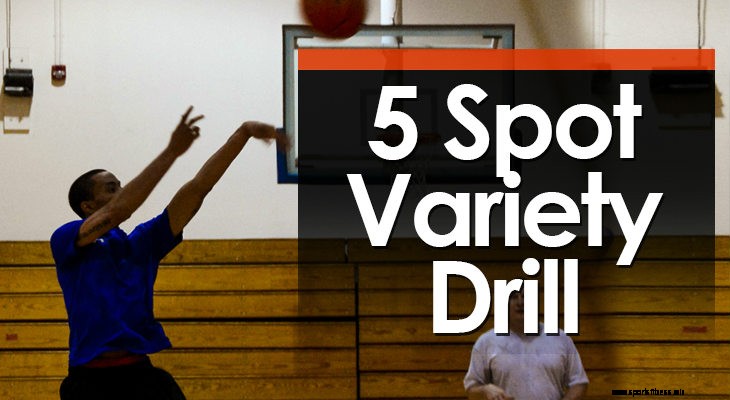
Cómo funciona el taladro:
All players grab a basketball and line up behind the same cone. Each player takes four different shots from 5 different cones. The core four shots are two layups and two jump shots.
Objetivo:
A great drill for practicing a variety of shots from all over the floor. While I’m usually against lines, this drill moves quite fast and the players will never be standing for too long.
Configuración:
- Place 5 cones three feet outside the three-point line at 5 different spots on the court. Both baselines, both wings, and the top of the key.
- All players need a basketball.
- All players line up behind the same cone.
- We don’t want more than 7 players in this drill at one time. If you have a lot of players, use both ends of the court.
- The players will do a full round of each shot before changing shots so you must tell them which shot they’ll be shooting first.
Instrucciones:
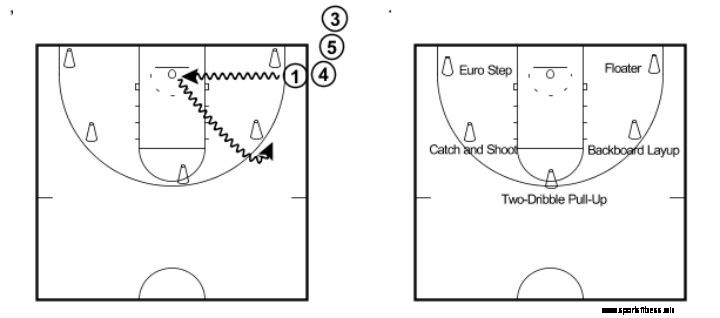 Cómo funciona el taladro:
Cómo funciona el taladro:All players grab a basketball and line up behind the same cone. Each player takes four different shots from 5 different cones. The core four shots are two layups and two jump shots.
Objetivo:
A great drill for practicing a variety of shots from all over the floor. While I’m usually against lines, this drill moves quite fast and the players will never be standing for too long.
Configuración:
• Place 5 cones three feet outside the three-point line at 5 different spots on the court. Both baselines, both wings, and the top of the key.
• All players need a basketball.
• All players line up behind the same cone.
• We don’t want more than 7 players in this drill at one time. If you have a lot of players, use both ends of the court.
• The players will do a full round of each shot before changing shots so you must tell them which shot they’ll be shooting first.
Instrucciones:
Each player will shoot five shots:
- A floater
- A layup off the backboard
- Two dribble pull-up shot.
- Pass to coach, receive the pass back for a shot.
- A euro step.
- All players are in the same line on a baseline cone.
- If the coach decides to start with a floater, the first player in the line will take a few dribbles in, take a floater, and make or miss will join the next cone.
- As soon as the first player in line shoots the ball, the next player starts dribbling in. This continues until all players have taken a shot from the first cone.
- When the last person is finished the first cone, the first player in line on the second cone will repeat what they did on the previous cone. This continues until everyone has shot from all the cones.
- The players end up on the first cone again, the coach picks the new shot, and the same routine happens. Do this for all four different shots.
Variaciones:
Add Different Shots - The four I mentioned at the start are the staples we use every time in this drill. But if you’d like you can add the different shots like the euro step, a three-point shot, a reverse layup, a power layup, etc.
All Shots on Same Cone - Instead of the players rotating straight onto the next cone, if you’d like they can just join the end of the same line and go through all the different shots before moving to the next cone.
Each player will shoot five shots:- A floater
- A layup off the backboard
- Two dribble pull-up shot.
- Pass to coach, receive the pass back for a shot.
- A euro step.
1. All players are in the same line on a baseline cone.
2. If the coach decides to start with a floater, the first player in the line will take a few dribbles in, take a floater, and make or miss will join the next cone.
3. As soon as the first player in line shoots the ball, the next player starts dribbling in. This continues until all players have taken a shot from the first cone.
4. When the last person is finished the first cone, the first player in line on the second cone will repeat what they did on the previous cone. This continues until everyone has shot from all the cones.
5. The players end up on the first cone again, the coach picks the new shot, and the same routine happens. Do this for all four different shots.
Variaciones:
Add Different Shots - The four I mentioned at the start are the staples we use every time in this drill. But if you’d like you can add the different shots like the euro step, a three-point shot, a reverse layup, a power layup, etc.
All Shots on Same Cone - Instead of the players rotating straight onto the next cone, if you’d like they can just join the end of the same line and go through all the different shots before moving to the next cone.
Drill #17 - Drive and Kick
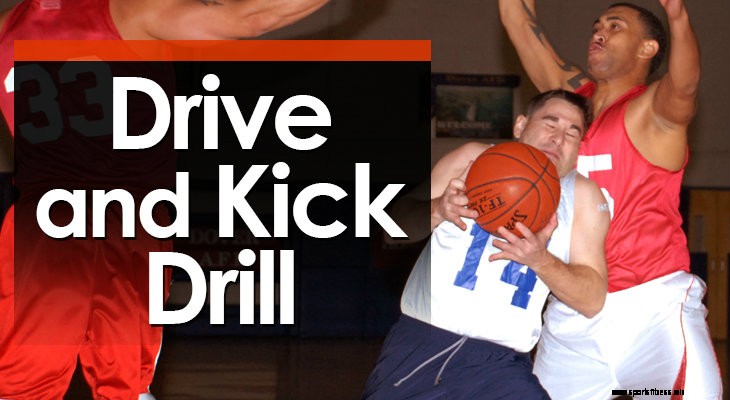
Cómo funciona el taladro:
Players will attack gaps in the defense with two hard dribbles before passing the ball out to the open shooter. This happens twice around the key before finally kicking the ball out for the open corner three-pointer.
Objetivo:
This drill teaches your players how to explode off the dribble and attack gaps in the defense, forcing defenders to help, before passing it out to a teammate for an open shot. To keep the drill fun and competitive, the last player takes a shot from the corner.
Configuración:
- One player under the ring with a basketball.
- One player on each corner and one at the top of the key.
- The rest of your players on the baseline waiting to come in.
Instrucciones:
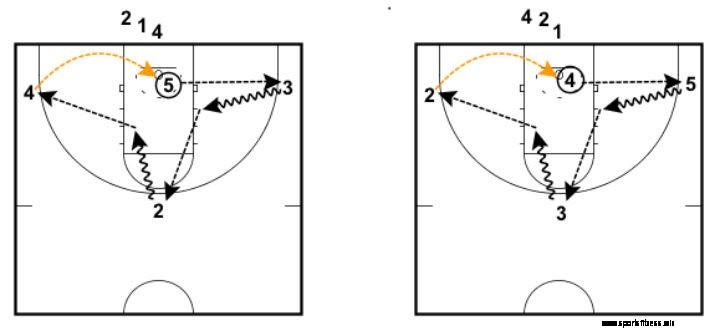 Cómo funciona el taladro:
Cómo funciona el taladro:Players will attack gaps in the defense with two hard dribbles before passing the ball out to the open shooter. This happens twice around the key before finally kicking the ball out for the open corner three-pointer.
Objetivo:
This drill teaches your players how to explode off the dribble and attack gaps in the defense, forcing defenders to help, before passing it out to a teammate for an open shot. To keep the drill fun and competitive, the last player takes a shot from the corner.
Configuración:
• One player under the ring with a basketball.
• One player on each corner and one at the top of the key.
• The rest of your players on the baseline waiting to come in.
Instrucciones:
- The player with the ball under the ring (5) will pass it to (3) in the corner and then fill their place.
- (3) will attack the key with two hard dribbles before passing to (2) at the top of the key and then fill their place.
- (2) will also attack the key with two hard dribbles before passing to (4) and then will fill their place.
- (4) will take the shot from the corner and then join the end of the line.
- The next person in the line out of bounds will rebound the shot by (4) and pass it to the corner.
- Repeat for the required amount of minutes.
Scoring System:
The drill is run against a time limit. I usually run it for 3 or 4 minutes.
- The corner three-pointer is worth 3 points.
- If the rebounder catches the ball before it hits the ground a put-back is worth 2 points.
Variaciones:
Tiempo - Vary the amount of time you run this drill depending on the age of your players.
Shot Distance - If you’re coaching young players you can move the shooting corner in a bit and allow them to shoot from the mid-range.
Change Direction - Make sure you change the direction up half-way so that players are practicing to be confident driving with either hand.
One Hand or Two Hand Passing - While I believe young youth players should certainly master the two-handed pass first, as players get older they must get used to passing with one hand off the dribble.
Practice Shot Fakes and Jabs - This is also a great drill to teach shot fakes and jabs before being explosive with correct footwork. Each time a player receives the ball get them to make a fake before driving.
1. The player with the ball under the ring (5) will pass it to (3) in the corner and then fill their place.2. (3) will attack the key with two hard dribbles before passing to (2) at the top of the key and then fill their place.
3. (2) will also attack the key with two hard dribbles before passing to (4) and then will fill their place.
4. (4) will take the shot from the corner and then join the end of the line.
5. The next person in the line out of bounds will rebound the shot by (4) and pass it to the corner.
6. Repeat for the required amount of minutes.
Scoring System:
The drill is run against a time limit. I usually run it for 3 or 4 minutes.
1. The corner three-pointer is worth 3 points.
2. If the rebounder catches the ball before it hits the ground a put-back is worth 2 points.
Variaciones:
Time - Vary the amount of time you run this drill depending on the age of your players.
Shot Distance - If you’re coaching young players you can move the shooting corner in a bit and allow them to shoot from the mid-range.
Change Direction - Make sure you change the direction up half-way so that players are practicing to be confident driving with either hand.
One Hand or Two Hand Passing - While I believe young youth players should certainly master the two-handed pass first, as players get older they must get used to passing with one hand off the dribble.
Practice Shot Fakes and Jabs - This is also a great drill to teach shot fakes and jabs before being explosive with correct footwork. Each time a player receives the ball get them to make a fake before driving.
Drill #18 - Titan Shooting
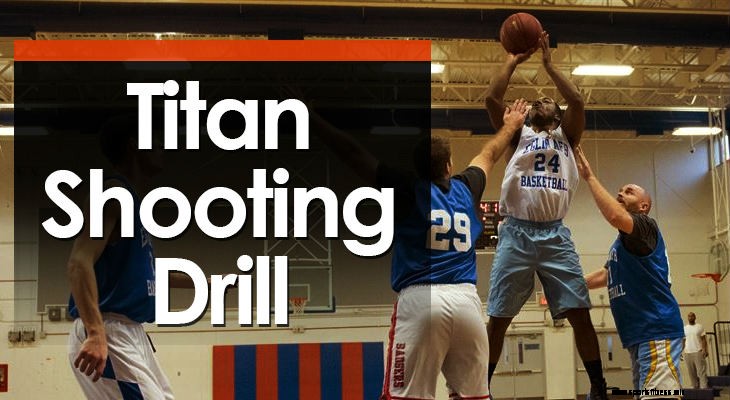
Cómo funciona el taladro:
Players begin the drill in three lines across the free-throw line on one basket. They must shoot, rebound their shot, pass it back to the same line, and then run a certain distance of the floor before returning to any of the lines. The team attempts to make a certain number of shots against a time limit.
Objetivo:
A fantastic team conditioning shooting drill if you have a limited number of baskets.
Configuración:
- Only one basket needed.
- Three lines of players. One on each high post and one in the middle of the free throw line.
- One basketball at the front of each line.
- The coach picks a line that the players must run to depending on the amount of players and age of the players.
Instrucciones:
Cómo funciona el taladro:Players begin the drill in three lines across the free-throw line on one basket. They must shoot, rebound their shot, pass it back to the same line, and then run a certain distance of the floor before returning to any of the lines. The team attempts to make a certain number of shots against a time limit.
Objetivo:
A fantastic team conditioning shooting drill if you have a limited number of baskets.
Configuración:
• Only one basket needed.
• Three lines of players. One on each high post and one in the middle of the free throw line.
• One basketball at the front of each line.
• The coach picks a line that the players must run to depending on the amount of players and age of the players.
Instrucciones:
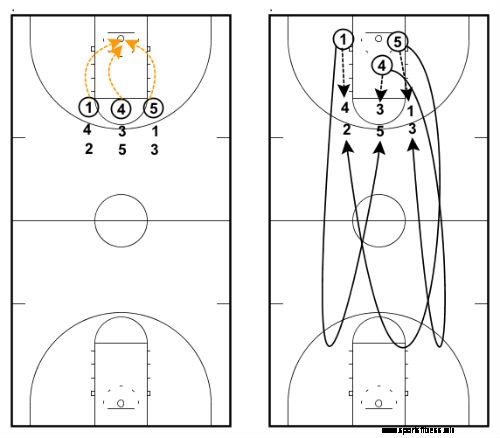
- The first player in each line shoots the ball, gets their own rebound, and passes it back to the same line they shot from.
- After passing back to the line, the player must run to the designated line chosen by the coach and then sprint back and join a different line.
- This process continues for all players until the time limit is up. Usually run for 2 - 4 minutes at a time.
Scoring System:
- The coach sets a target amount of makes before the drill and the players have a certain amount of time to achieve it.
- Each basket is worth one point.
- The coach should write down the score at the end of the drill and that can be used as the target to beat whenever you run the drill in the future.
Variaciones:
Tiempo - I usually run this drill for three minutes but you can change the length depending on the level and age of your players.
Running Distance - Depending on the amount of players and the amount of space you have, you can vary the distance that players run between these four options:
una. No running. Join the end of the line after shot.
B. Run to half court.
C. Run to opposite free throw line.
D. Run full court.
Shooting Distance - If you have older players that utilise the three point shot, you can run the Titan Shooting drill from the three point line.
Competition - Instead of setting a target number for your whole squad, you can split the squad into two different teams and run the Titan Shooting drill at opposite ends of the floor against each other.
1. The first player in each line shoots the ball, gets their own rebound, and passes it back to the same line they shot from.2. After passing back to the line, the player must run to the designated line chosen by the coach and then sprint back and join a different line.
3. This process continues for all players until the time limit is up. Usually run for 2 - 4 minutes at a time.
Scoring System:
• The coach sets a target amount of makes before the drill and the players have a certain amount of time to achieve it.
• Each basket is worth one point.
• The coach should write down the score at the end of the drill and that can be used as the target to beat whenever you run the drill in the future.
Variaciones:
Time - I usually run this drill for three minutes but you can change the length depending on the level and age of your players.
Running Distance - Depending on the amount of players and the amount of space you have, you can vary the distance that players run between these four options:
una. No running. Join the end of the line after shot.
B. Run to half court.
C. Run to opposite free throw line.
D. Run full court.
Shooting Distance - If you have older players that utilise the three point shot, you can run the Titan Shooting drill from the three point line.
Competition - Instead of setting a target number for your whole squad, you can split the squad into two different teams and run the Titan Shooting drill at opposite ends of the floor against each other.
Drill #19 - Rainbow Shooting
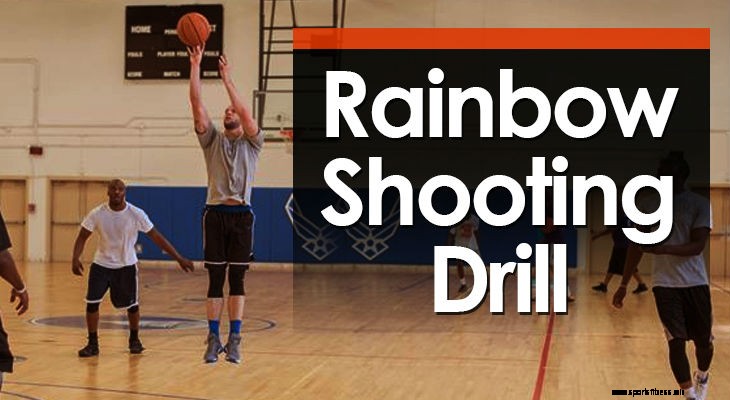
Cómo funciona el taladro:
The drill consists of two basketballs and players shooting from different spots on the floor. Each time a player will pass to a shooter and then perform a half-circle around the back of the shooter before receiving the pass from the opposite line. Each player rebounds their own shot and passes the ball back to the line they received the pass from.
Objetivo:
This is a great warm-up and shooting drill especially for youth basketball. It gives players a chance to shoot many repetitions from all different spots on the floor and it’s high intensity with everyone encouraging each other.
Configuración:
- Two lines on the baseline at about the width of the key lane.
- Two basketballs. One to the first person in one of the lines, and the other to the second person in the other line (because the first person in the line without a basketball will be the first player to cut).
- Players divide up so that both lines have about an even number of players.
Instrucciones:
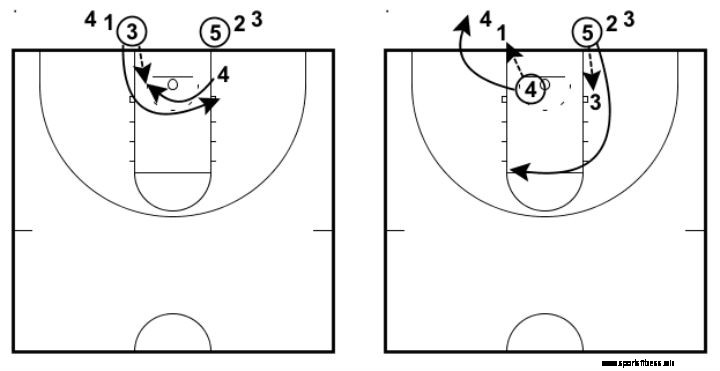 Cómo funciona el taladro:
Cómo funciona el taladro:The drill consists of two basketballs and players shooting from different spots on the floor. Each time a player will pass to a shooter and then perform a half-circle around the back of the shooter before receiving the pass from the opposite line. Each player rebounds their own shot and passes the ball back to the line they received the pass from.
Objetivo:
This is a great warm-up and shooting drill especially for youth basketball. It gives players a chance to shoot many repetitions from all different spots on the floor and it’s high intensity with everyone encouraging each other.
Configuración:
• Two lines on the baseline at about the width of the key lane.
• Two basketballs. One to the first person in one of the lines, and the other to the second person in the other line (because the first person in the line without a basketball will be the first player to cut).
• Players divide up so that both lines have about an even number of players.
Instrucciones:
- The player at the front of the line without a ball does a half circle and receives the pass off the player at the front of the other line. The player that received the pass does a layup, rebounds the ball, and then passes to the line he received the ball off. Then joins that line.
- The player that passes to the shooter does a half-circle behind the shooter to the other side and receives the pass. Same as the first player, they do a layup, rebote, and then pass to the line they received off.
- This continues until all players have shot a layup from both sides or until you’ve made the required amount of shots from a particular spot.
- Once completed, they then move onto the next shot. I have 5 different spots my players must all shoot from twice. Your spots may be different depending on age.
una. A layup.
B. From the block.
C. From the elbow.
D. From the 3-point line.
mi. Fake and drive.
Scoring System:
- For this drill the whole team scores together. The coach sets a number of makes from each spot and the players must count out loud as they make shots.
- For example the team might make 20 layups, 15 shots from the block, 10 shots from the elbow, 5 threes, and then 20 fake and drive layups.
Variaciones:
Different Shooting Spots - Don’t limit your team to the 5 examples I use above. You can incorporate shots from the wing, post ups, 1-dribble pull-ups, etc. Be creative.
1. The player at the front of the line without a ball does a half circle and receives the pass off the player at the front of the other line. The player that received the pass does a layup, rebounds the ball, and then passes to the line he received the ball off. Then joins that line.2. The player that passes to the shooter does a half-circle behind the shooter to the other side and receives the pass. Same as the first player, they do a layup, rebote, and then pass to the line they received off.
3. This continues until all players have shot a layup from both sides or until you’ve made the required amount of shots from a particular spot.
4. Once completed, they then move onto the next shot. I have 5 different spots my players must all shoot from twice. Your spots may be different depending on age.
una. A layup.
B. From the block.
C. From the elbow.
D. From the 3-point line.
mi. Fake and drive.
Scoring System:
• For this drill the whole team scores together. The coach sets a number of makes from each spot and the players must count out loud as they make shots.
• For example the team might make 20 layups, 15 shots from the block, 10 shots from the elbow, 5 threes, and then 20 fake and drive layups.
Variaciones:
Different Shooting Spots - Don’t limit your team to the 5 examples I use above. You can incorporate shots from the wing, post ups, 1-dribble pull-ups, etc. Be creative.
Drill #20 - 31 Shooting Drill
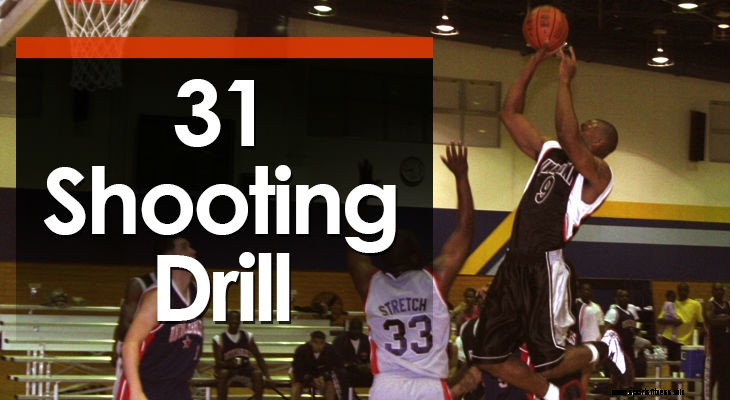
Cómo funciona el taladro:
Each group will be competing against each other to be the first group to reach 31 points. The players will each take three shots - one from the 3-point line, one from outside the key, and one inside the key - and have the potential to score 6 points before passing to the next player in the group.
Objetivo:
To work on shooting from all different spots on the basketball court while under pressure and at game speed.
Configuración:
- Split the players you have up into 4 even groups and get them to form a line outside the 3-point line on each wing.
- 3 - 5 players in each team.
- First person in each line needs a ball.
Instrucciones:
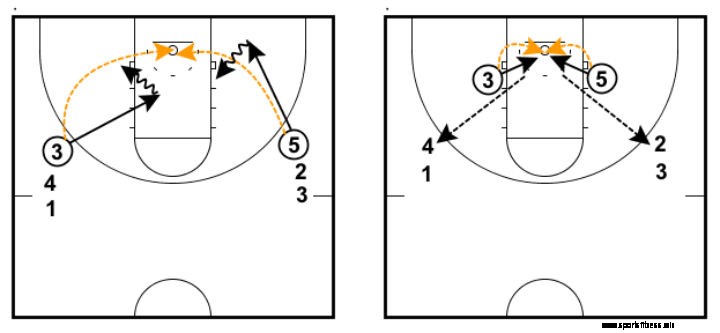
- On the coach’s whistle, the first person in each line will take a shot from the three-point line. If they make it, their team receives three points.
- Irrelevant of whether the shot is made or not, the shooter will get the rebound, retreat outside of the key, and take another mid-range jump shot. This shot is worth two points.
- The player will again rebound their shot, and this time they’re allowed to take a shot inside the key. This shot is worth one point.
- They then rebound the ball once more and pass it to the next player in the group who repeats the same process.
Scoring System:
- The game has no time limit. The goal is to score 31 points as a group. When a group reaches 31 points they call out ’31’ and are the winning team.
- The points are scored as follows:
- Three-point shot - 3 points
- Outside the key - 2 points
- Inside the key - 1 point - Each player has a maximum of three shots each time it’s their go.
Variaciones:
Youth Players - Instead of shooting from the three-point line, have each group start on the elbow. This means the first shot is from the elbow (worth 3 points), the second shot is from outside the key (worth 2 points), and the third shot is from inside the key (worth 1 point).
Different Target Amount of Points - Instead of playing to 31, you can play till 11, 21, or even 41.
1. On the coach’s whistle, the first person in each line will take a shot from the three-point line. If they make it, their team receives three points.2. Irrelevant of whether the shot is made or not, the shooter will get the rebound, retreat outside of the key, and take another mid-range jump shot. This shot is worth two points.
3. The player will again rebound their shot, and this time they’re allowed to take a shot inside the key. This shot is worth one point.
4. They then rebound the ball once more and pass it to the next player in the group who repeats the same process.
Scoring System:
• The game has no time limit. The goal is to score 31 points as a group. When a group reaches 31 points they call out ’31’ and are the winning team.
• The points are scored as follows:
- Three-point shot - 3 points
- Outside the key - 2 points
- Inside the key - 1 point
• Each player has a maximum of three shots each time it’s their go.
Variaciones:
Youth Players - Instead of shooting from the three-point line, have each group start on the elbow. This means the first shot is from the elbow (worth 3 points), the second shot is from outside the key (worth 2 points), and the third shot is from inside the key (worth 1 point).
Different Target Amount of Points - Instead of playing to 31, you can play till 11, 21, or even 41.How the Drill Works:
Each group will be competing against each other to be the first group to reach 31 points. The players will each take three shots - one from the 3-point line, one from outside the key, and one inside the key - and have the potential to score 6 points before passing to the next player in the group.
Objetivo:
To work on shooting from all different spots on the basketball court while under pressure and at game speed.
Configuración:
• Split the players you have up into 4 even groups and get them to form a line outside the 3-point line on each wing.
• 3 - 5 players in each team.
• First person in each line needs a ball.
Instrucciones:
[20 ejercicios de tiro de baloncesto para disparos sin luces: https://es.sportsfitness.win/deportes/baloncesto/1008040762.html ]

 entrenamiento
entrenamiento Deportes extremos
Deportes extremos aptitud
aptitud Artes Marciales
Artes Marciales baloncesto
baloncesto baloncesto
baloncesto baloncesto
baloncesto